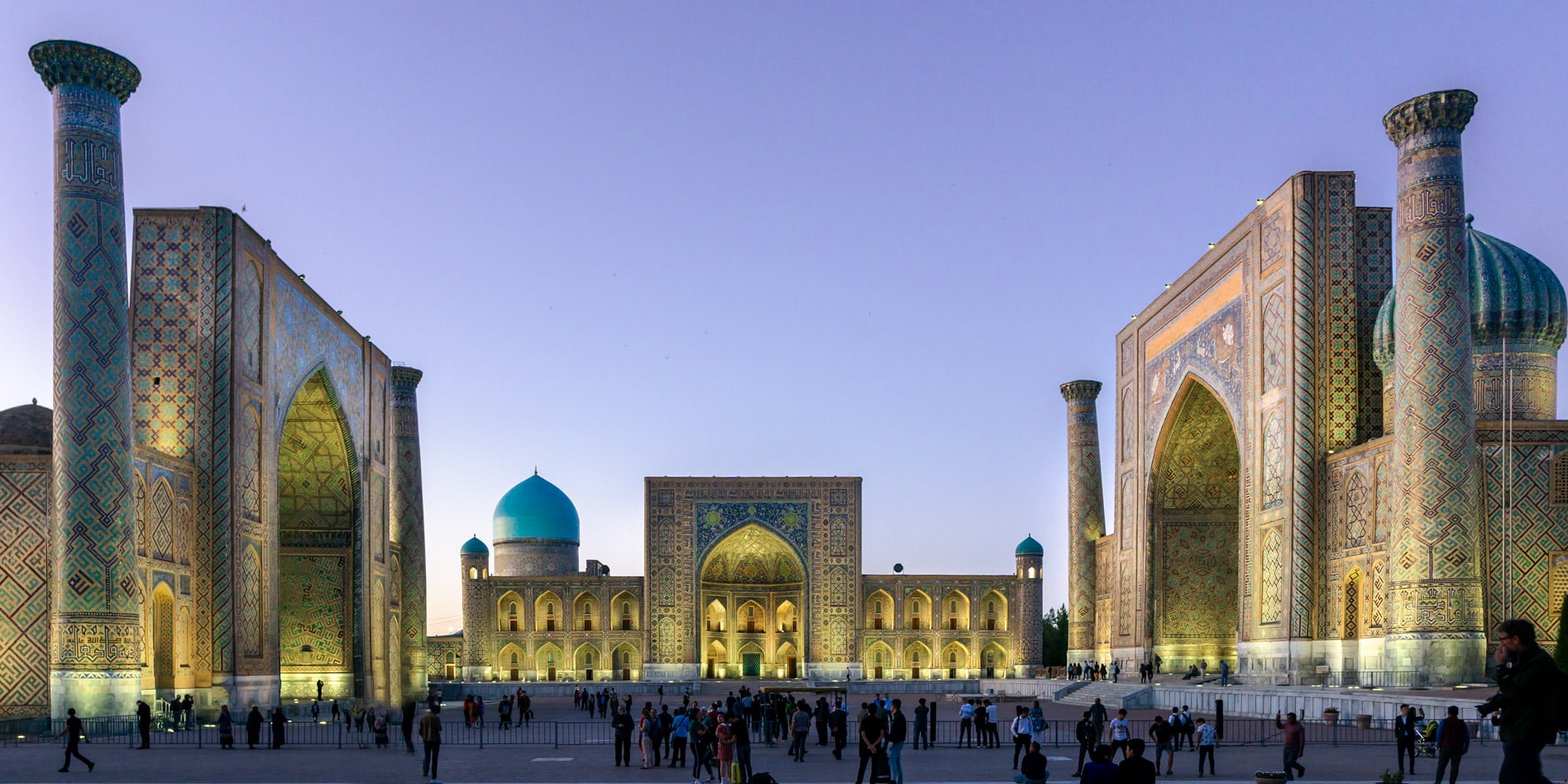We’ve travelled extensively through Uzbekistan and there’s a reason this ancient city is called the jewel in Uzbekistan’s crown. Based on our own experiences, we can say with an unequivocal yes that Samarkand is worth visiting.
In this article, we walk you through the wonders of Samarkand, including the grandeur of Registan Square and its amazing nighttime light show, the exquisite beauty of the Shah-I-Zinda necropolis and the countless architectural masterpieces found in this ancient city.
Of all the famous Uzbek cities (Tashkent, Bukhara and Khiva) we visited on the ancient Silk Road routes, Samarkand left the greatest impression. This city exquisitely showcases its ancient history, seamlessly blending the old with the modern day.
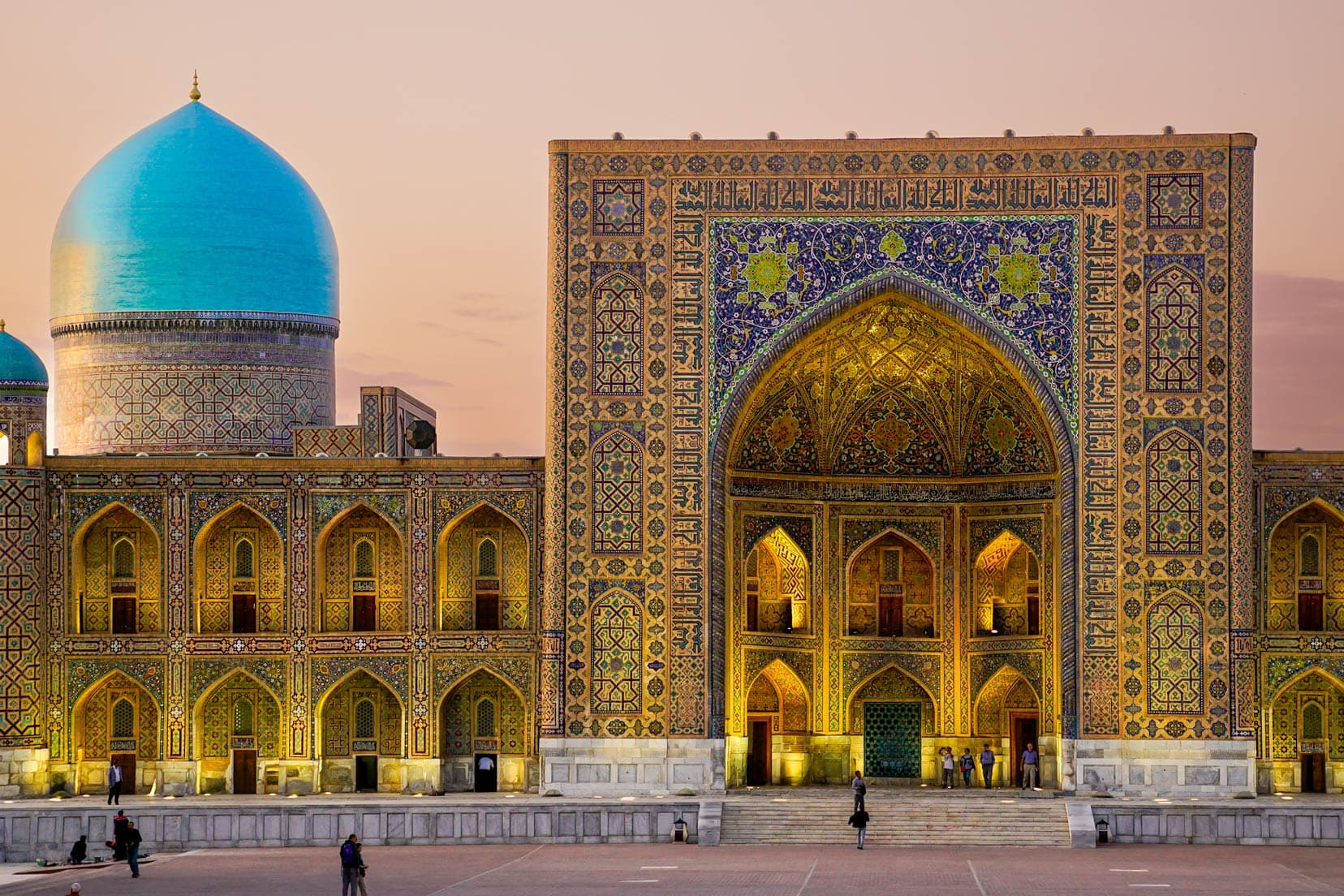
There are so many amazing things to do in Samarkand. So, to make it easier for you, we’ve put together a comprehensive list of its most interesting attractions.
We travelled through the country by train, car and plane, visiting all the main cities on our 2-week Uzbekistan itinerary.
Read on to find out why Samarkand is not only a favourite of ours but also so many others.
Samarkand in a Nutshell: Essential Highlights
Why Visit? Explore Samarkand, a vibrant testament to the Silk Road’s historical and cultural confluence. Renowned for its deep historical roots and stunning Islamic architecture, this UNESCO World Heritage site is a treasure trove of discovery.
Best Places to Visit in Samarkand
- Registan Square: The iconic symbol of Samarkand, featuring three grand madrasahs with exquisite facades.
- Samarkand Registan Light Show: Experience the magic of this nightly spectacle that brings the square to life with vibrant lights and historical narratives.
- Shah-I-Zinda: A striking avenue of mausoleums known for their intricate tile work and historical significance.
- Bibi Khanym Mosque: A massive mosque built by Timur, showcasing the architectural ambition of the Timurid era.
- Ulugbek Observatory: Visit the remains of a 15th-century observatory built by the astronomer King Ulugbek.
- Gur-e-Amir: The ornate mausoleum of Timur, rich in artistic and architectural detail.
- Siab Bazaar: Immerse yourself in the vibrant local culture and taste traditional Uzbek cuisine at this bustling market.
- Shah-i-Zinda Necropolis: Explore this complex of beautifully decorated mausoleums housing the tombs of Timurid royalty.
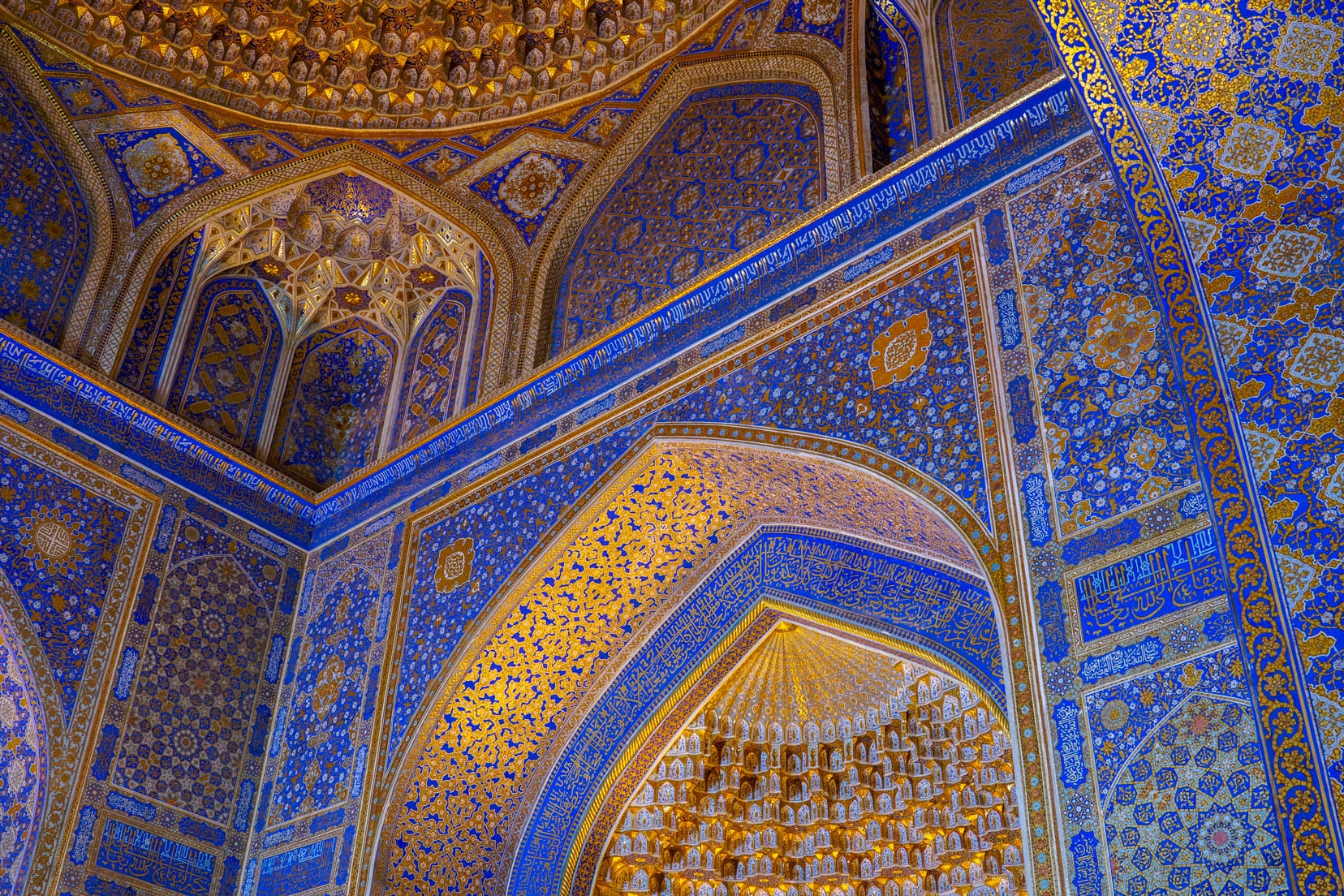
Best Samarkand Tours:
Best Travel Options
- By Train: Connect conveniently with other major cities in Uzbekistan through comfortable and scenic train rides.
- By Plane: Rapid flights from Tashkent drop you close to the city’s historical heart.
Accommodation Tips:
To be in the heart of Samarkand, choose accommodations close to Registan Square. Options are available for various budgets.
- Budget: Imran&Bek
- Mid-range: Crystal Guest House
- High-end Range: Mövenpick Samarkand
Culinary Delights:
Enjoy authentic Uzbek dishes at Sharq Shirinliklari and the best kebabs in town at Bobur Shashlik.
Ideal Visit Duration:
Spend at least two to three days to fully experience the grandeur of Samarkand’s historical sites and vibrant culture, with additional time recommended for deeper exploration.
Jump ahead using these links or continue to browse:
Map: Samarkand Attractions
How to Use This Samarkand Map
- To use this interactive map effectively, click the square icon in the upper right corner to expand.
- A key will appear on the left, guiding you through various locations.
- Clicking on any site reveals detailed information about that spot.
- Purple marker (🟣) shows an attraction
- Blue marker (🔵) indicates cafe/restaurant
- Yellow marker (🟡) indicates tourist information
- Green marker (🟢) indicates the accommodation option
- Black marker (⚫️) indicates the railway station
Why Visit Samarkand?
Over the centuries, this southern Uzbek city of Samarkand has worn the scars of battle — having been conquered, destroyed and rebuilt by the likes of Alexander The Great and Genghis Khan.
As one of Central Asia’s oldest continually inhabited cities, Samarkand formed an important trading post along the ancient Silk Road route.
More recently, Samarkand’s remarkable ancient structures and historic sites are proving to be a major drawcard for visitors, gaining international acclaim and affirming that Samarkand is worth visiting.
In 2001, the historic centre of Samarkand was included in the UNESCO World Heritage List.
A visit to Samarkand is truly unforgettable.
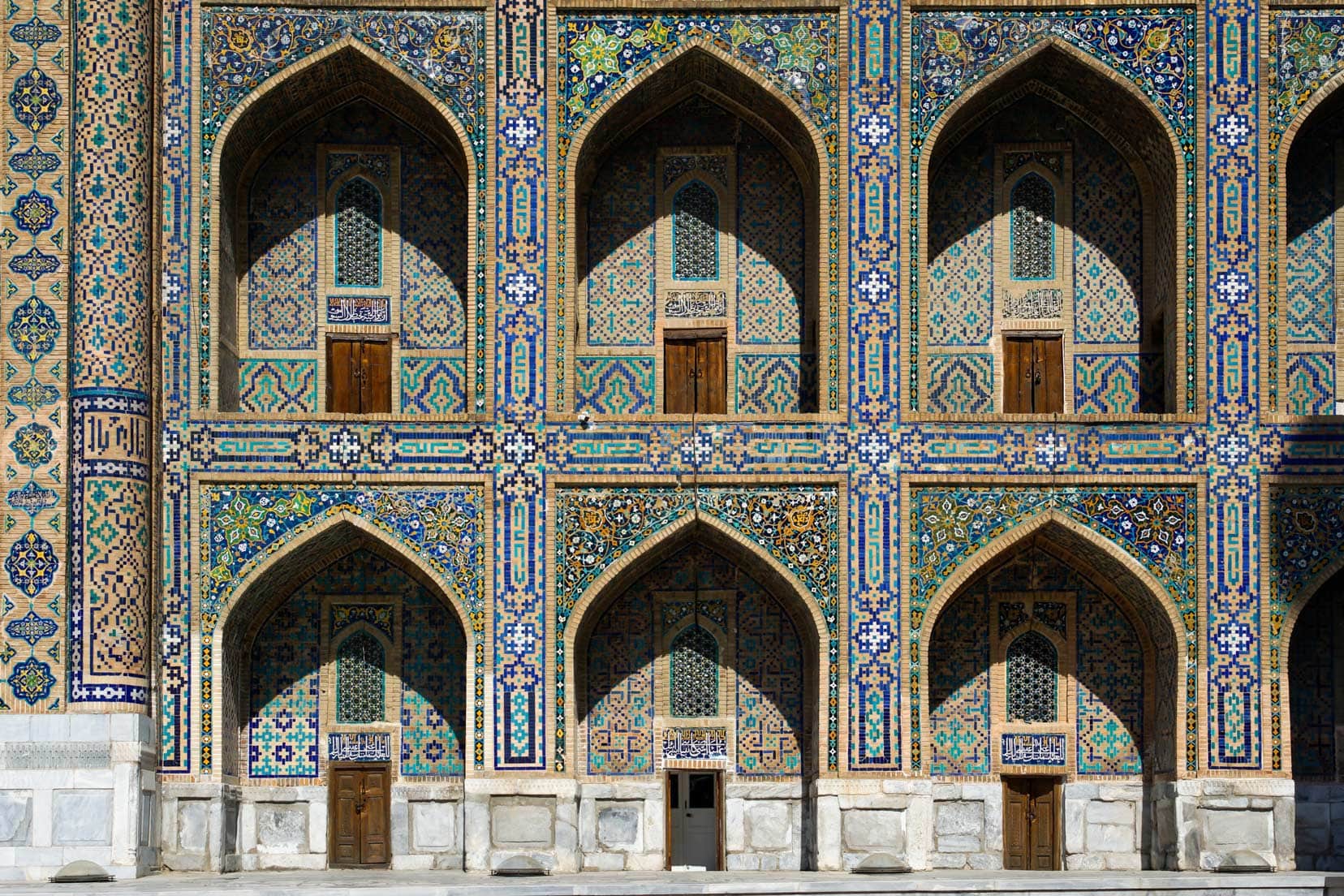
Best Way to See Samarkand
With its rolling landscape, Samarkand is a highly walkable city. Thanks to its extensive pedestrian areas, care has been given to traversing the city on foot.
Except for the Observatory of Ulugbek, the main attractions are concentrated within a 2.5-kilometre stretch. This means you won’t need to ping-pong around the city and can focus your time in this central area, making it easier to explore the most significant sites at a leisurely pace.
Although there are placards on the ancient buildings, in hindsight, having a guide with thorough knowledge of the history would have enhanced the experience. For a more immersive experience, you might consider joining a city tour:
Don’t have much time on your hands? Check out this 5.5-hour city tour, rated 5⭐️.
⏰ Short on Time: 5.5 hour Walk/Drive Samarkand City Tour
| ⭐️ 5/5 Star Reviews | 🚙 Air-con vehicle | Pick-up included |
| ❌ No wheelchair accessibility |
If you prefer a more leisurely experience, this two-day city tour has 5⭐️ reviews. The transport has onboard Wi-Fi, an English-speaking guide, and wheelchair access to sites.
🥾 2-Day Walk/Drive Samarkand City Tour 🚌
| ⭐️ 5/5 Star Reviews | Private Transport | ✅ Wheel-chair accessible sites |
Where to Stay in Samarkand
We would definitely recommend booking a hotel within a couple of kilometres of Registan Square.
Our mistake: We booked a hotel for our 3 days in Samarkand on the outskirts of town that has since closed, which is good news because it was awful! We met another couple who were staying near Registan Square and could stroll.
Here are three different budget accommodation options – all with fantastic reviews.
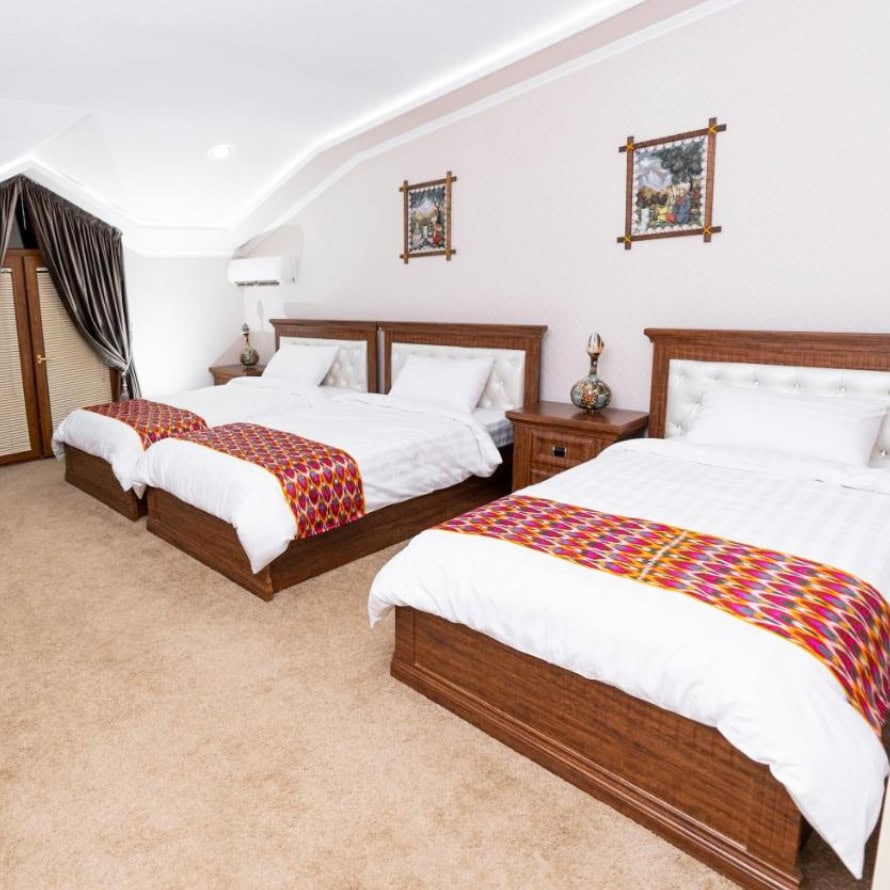
Rating: ⭐️ 9.8/10
⭐️⭐️⭐️⭐️
✔️ 0.9km to the city centre
✔️ Exceptional Breakfast
✔️ Free Wifi
High-End Option:
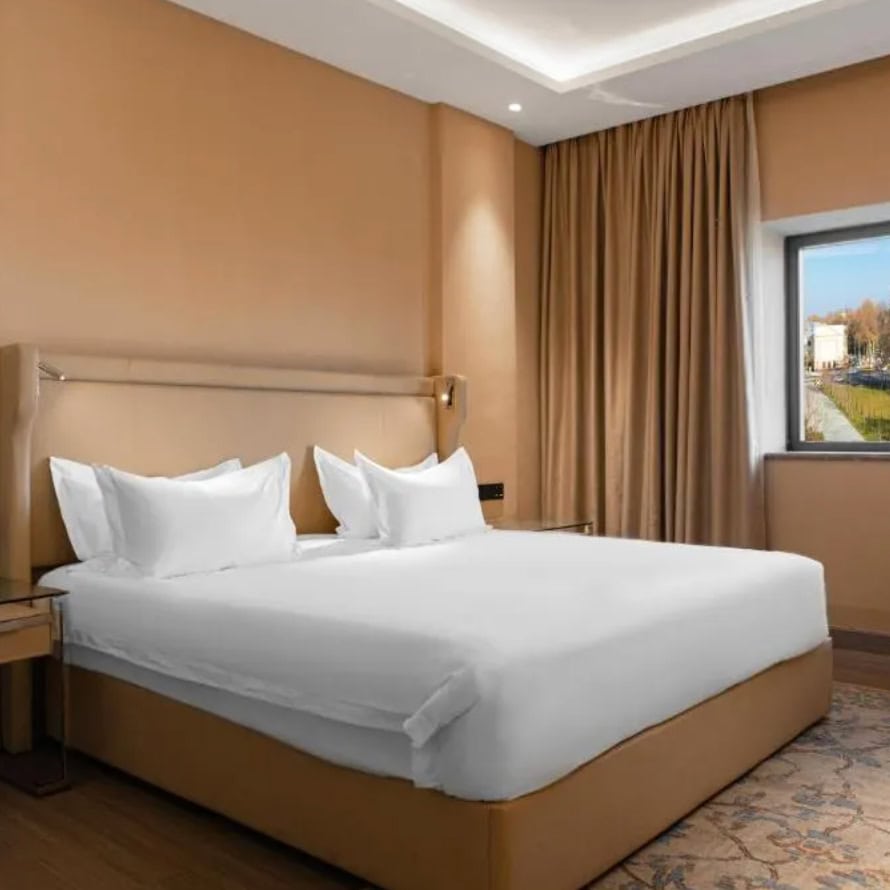
Rating: ⭐️ 8.2/10
⭐️⭐️⭐️⭐️⭐️
✔️ 0.5km to the city centre
✔️ Continental Breakfast Incl.
✔️ Free Wifi
15 Things to Do in Samarkand
Samarkand is a city where the allure of ancient history meets the pulse of modern culture. If you’re seeking a comprehensive experience that’s not just for the photo album, you’re in the right place. I’ve curated a list of 15 essential activities to help you explore Samarkand’s multifaceted beauty.
Drawing from my own firsthand experiences—and yes, those invaluable photos that serve as mementos—I aim to guide you through a well-rounded journey into this captivating destination.
1. Visit Registan Square
A fitting first stop is a visit to the majestic Registan Square. It’s a breathtaking sight.
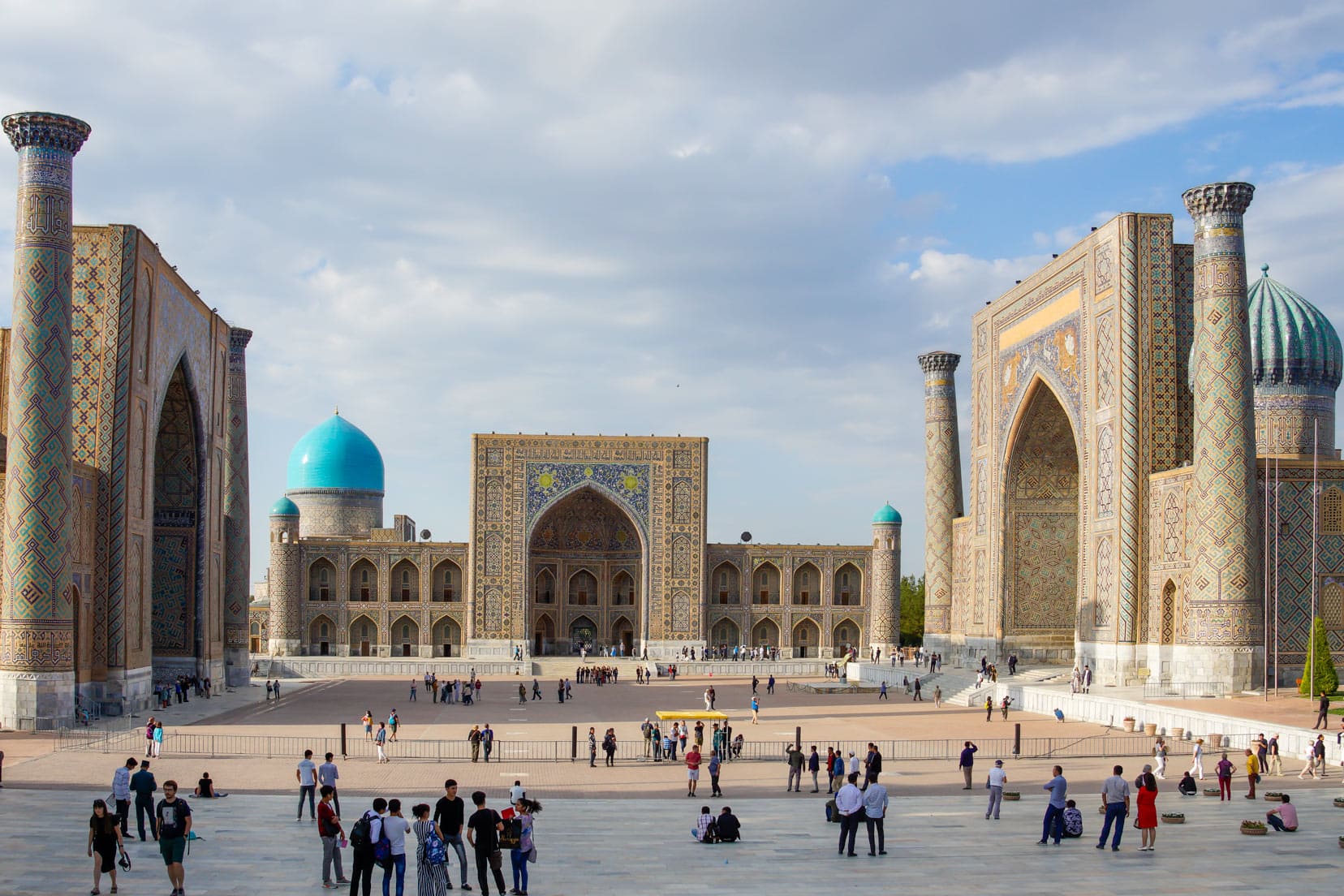
Registan Square consists of three monstrous madrasahs (or schools), each with unique facades:
- Ulughbek madrasah (to the left when at the square entrance. The square entrance is the open area in the above image.) Ulughbek was the first madrasah to be built during the 15th century.
- Tilla-Kori madrasah (directly ahead when at the entrance). Tilla-Kori was completed in the 17th century.
- Sher-Dor madrasah (to the right when at the entrance). Sher-Dor was completed in the 17th century.
The three madrasahs face a central open area, the original sand-covered square, where proclamations were made and markets were located.
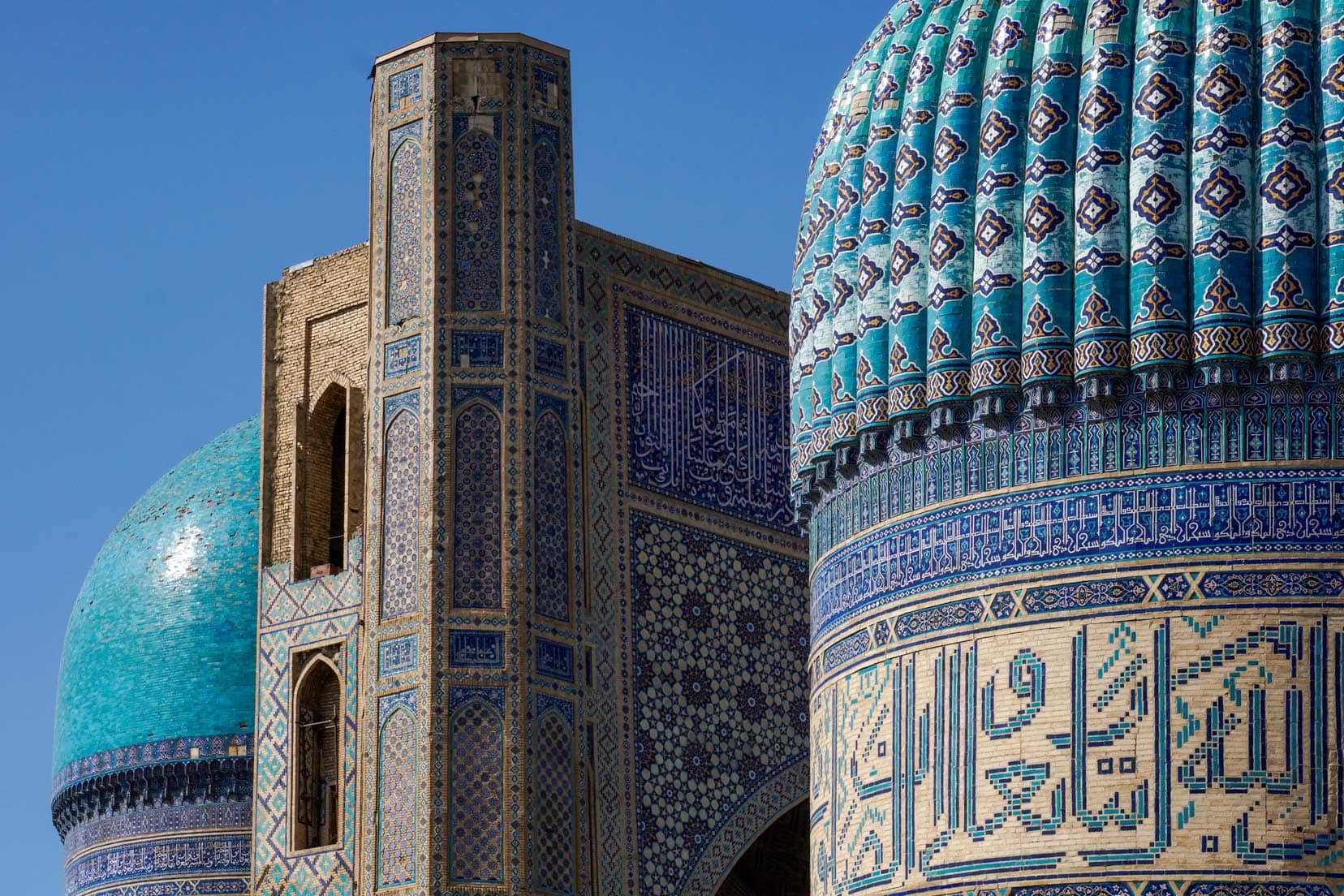
Entry into Registan Square, Samarkand
Officials control entry to Registan Square Samarkand at the fenced-off area of the square’s only entrance.
Tickets, valid for one-time entry during the following 24 hours, can be purchased with cash only from a ticket booth close to the main square entrance.
The entry price for foreigners is SOM 50,000 (USD $4.10), while Uzbek citizens enter for SOM 3,000 (USD $0.25). Gate officials check that you have a valid ticket.
Ulughbek Madrasah
The Ulughbek madrasah (the one on the left when at the square entrance) was built between 1417 and 1421 A.D. under the authority of the governor at the time, Ulugh Bek. He was a preeminent astronomer who also lectured on the subject at the madrasah.
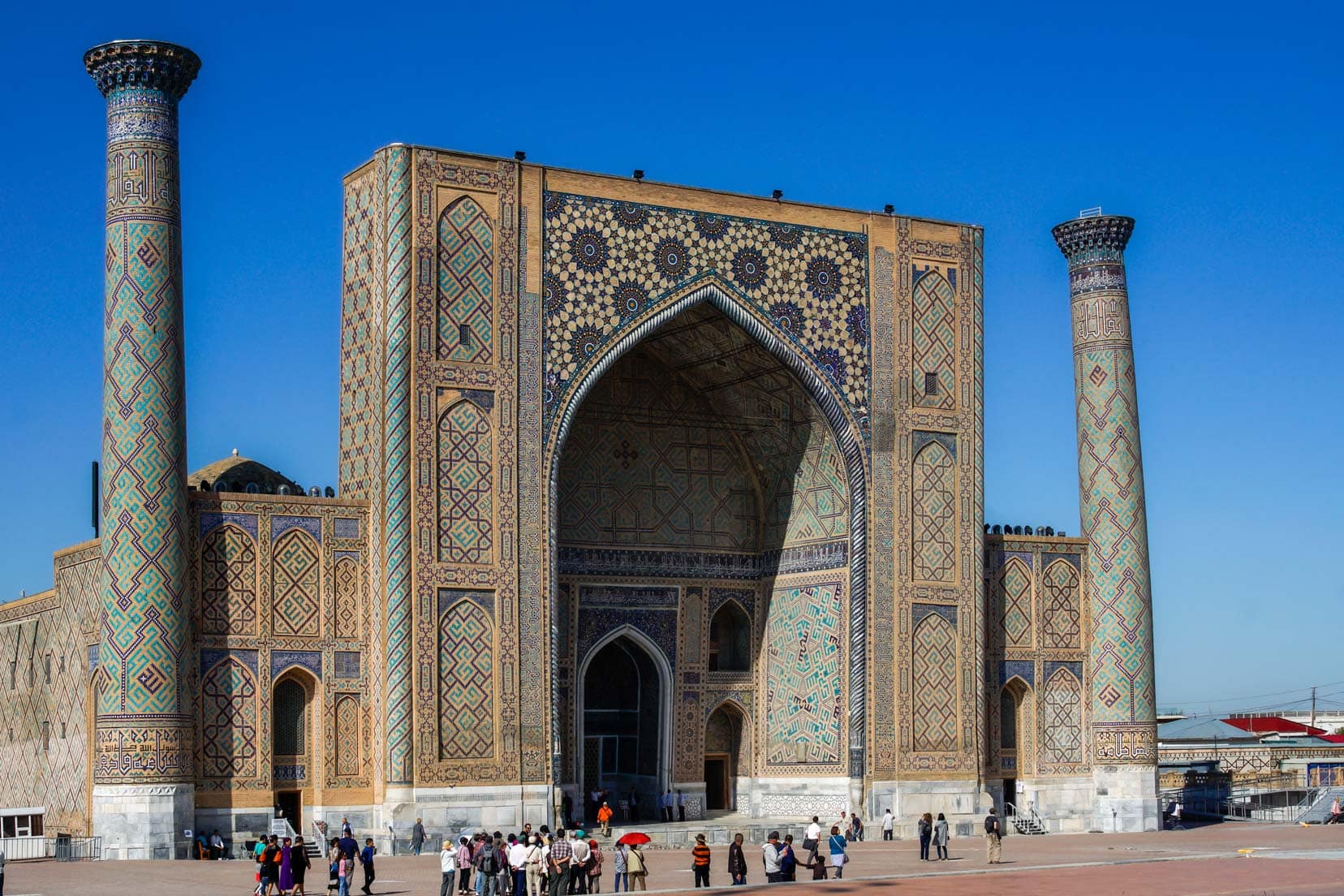
To give an idea of dimensions, the pishtak or front portal of the madrasah, is 35m in height and is adorned with azure-blue stars in his honour.
Upon entering the madrasah, a gold chamber displays exquisite form and colour mosaics. The architect had a real eye for detail.
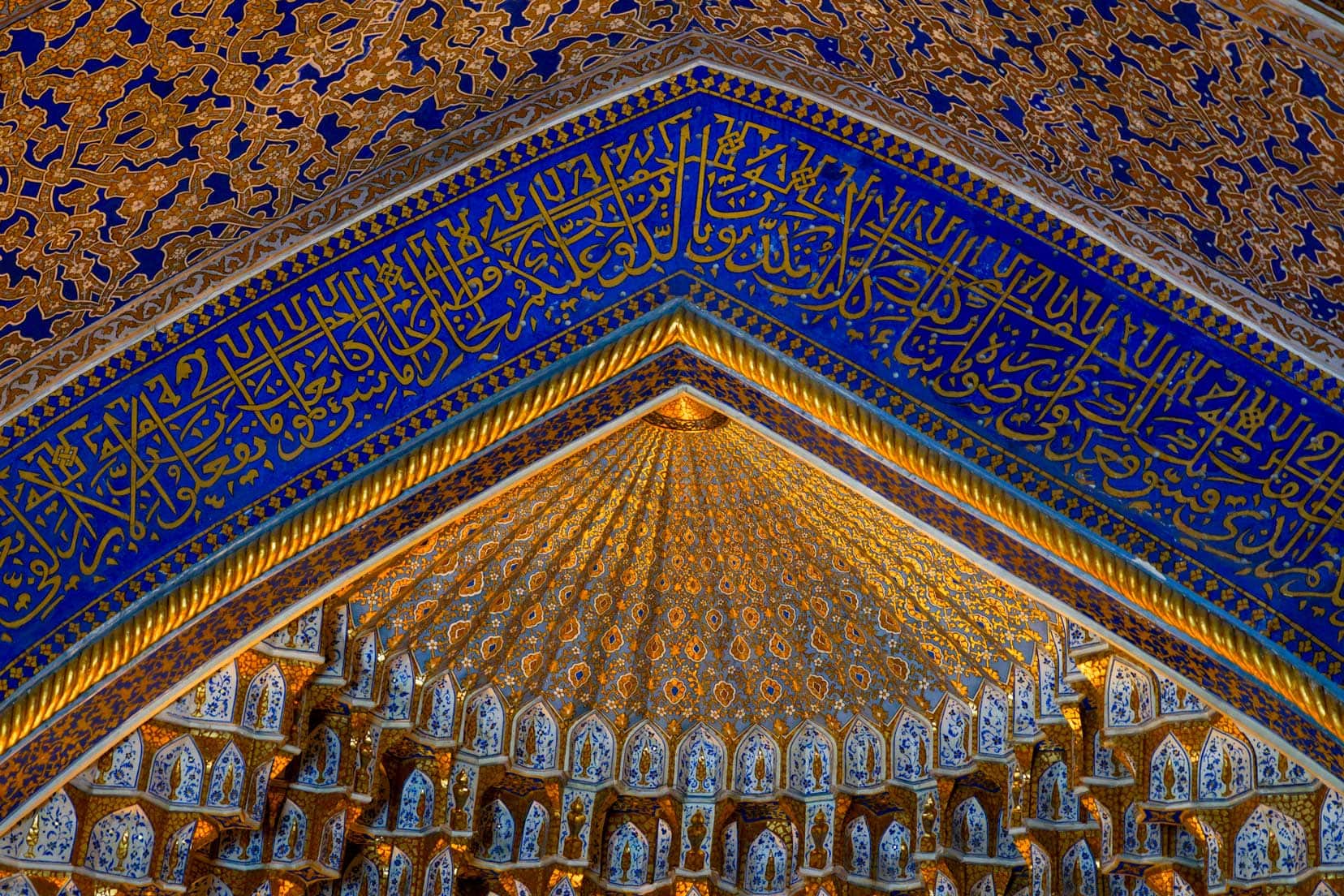
Planning a Trip to Uzbekistan?
- 🚗 Hiring a car? We recommend getting a quote from DiscoverCars
- ⛑ Arranged your travel insurance? Compare quotes from World Nomads & Safetywing
- 🪪 Order your International Driver’s Licence online here
- 🏩 Booked your accommodation? We use Booking.com to find the best deals
- 🐾 Is someone pet-sitting for you? 🐾 We use and love TrustedHousesitters
- (Get 25% off at checkout for new memberships with our discount code: LIFEJOURNEY25)
It isn’t possible to access the inner courtyard of Ulughbel madrasah; however, you can walk through the long hallway containing many old photographs captured at a time before the Russian restorations began.
Looking at these images, it’s obvious that the madrasahs fell into great disrepair over time.
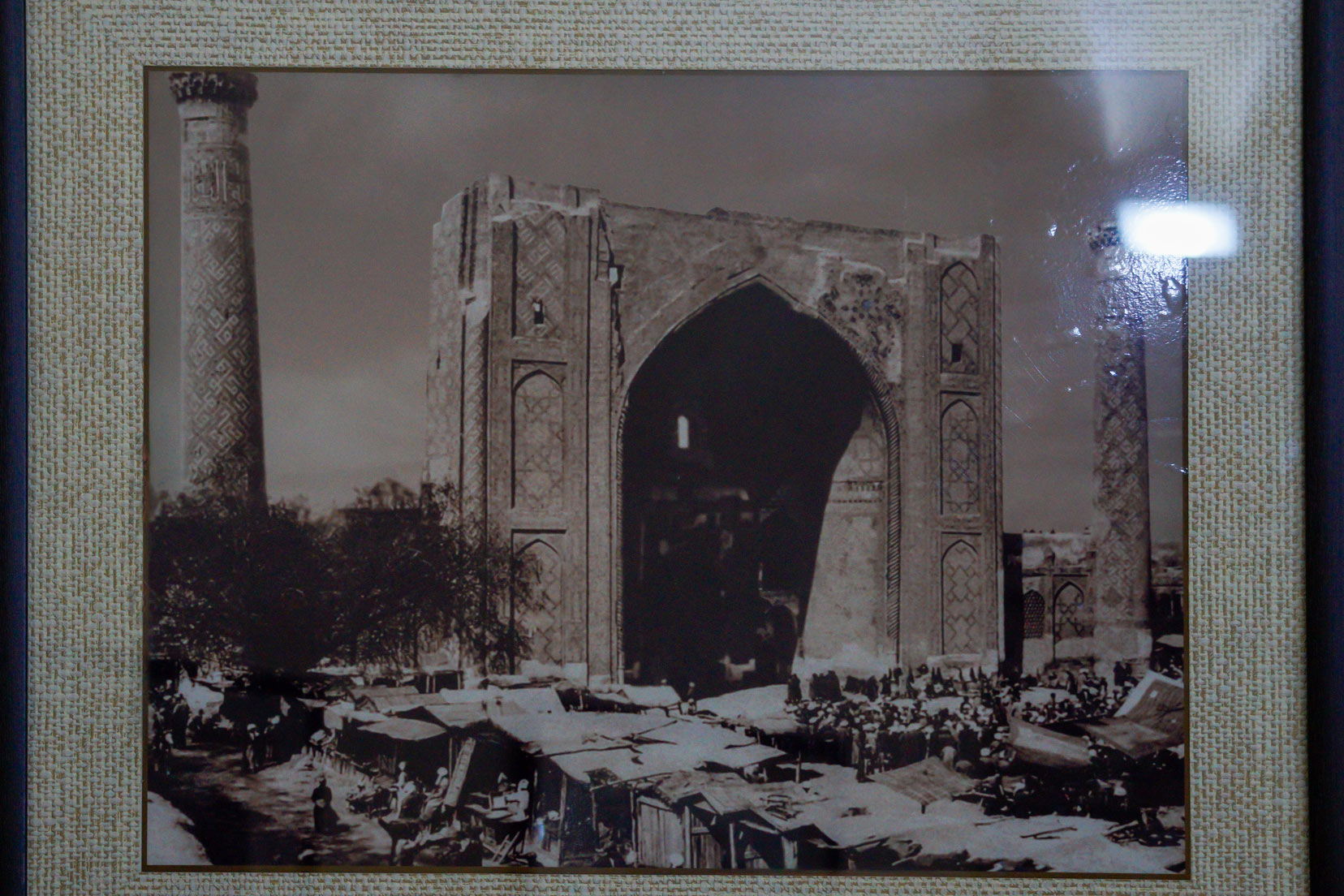
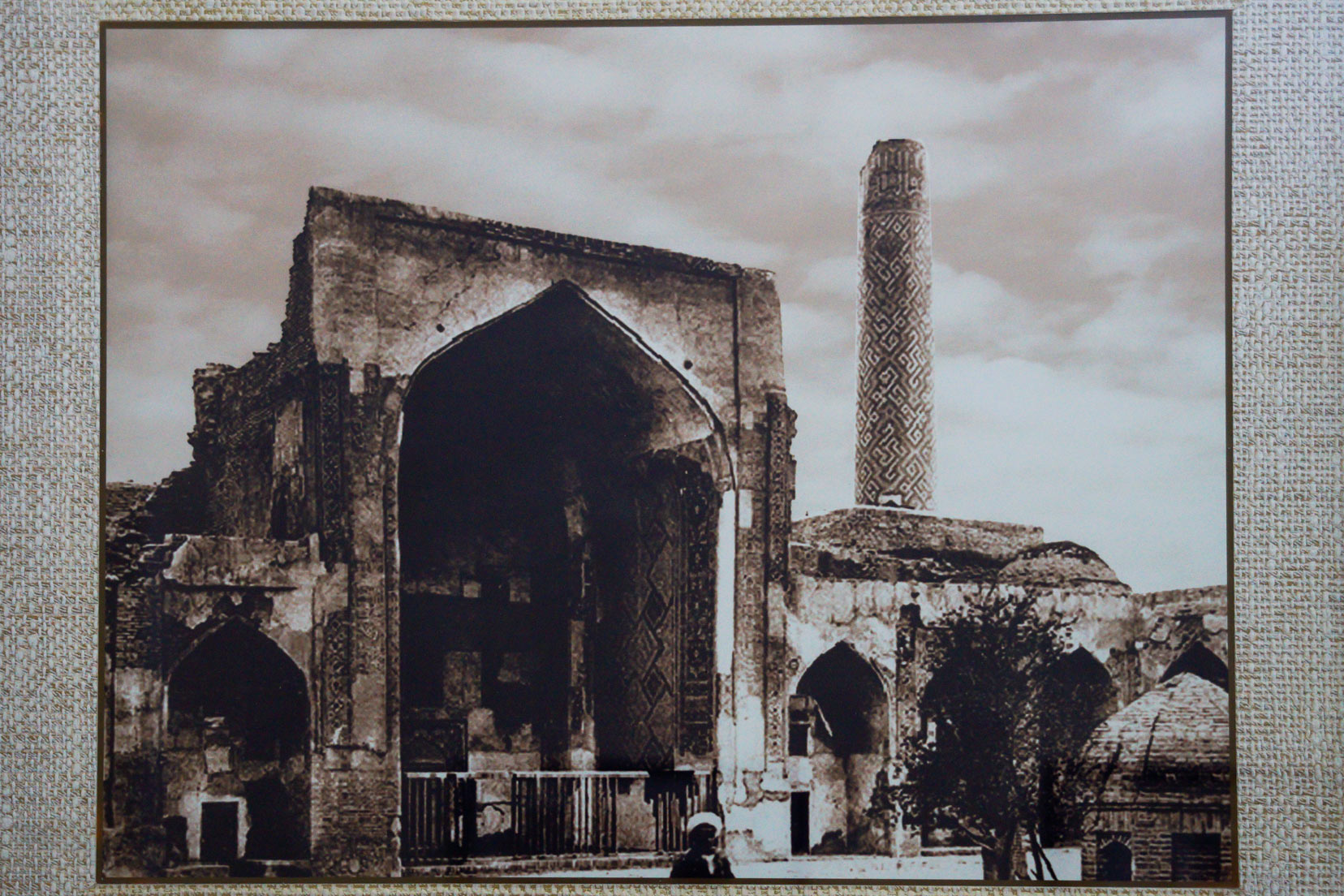
Tilla-Kori Madrasah
Tilla-Kori madrasah faces you when standing at the entrance to Registan Square with an interior with rich blue and gold trappings. This is not surprising as the name Tilla-Kori translates to ‘decorated with gold’.
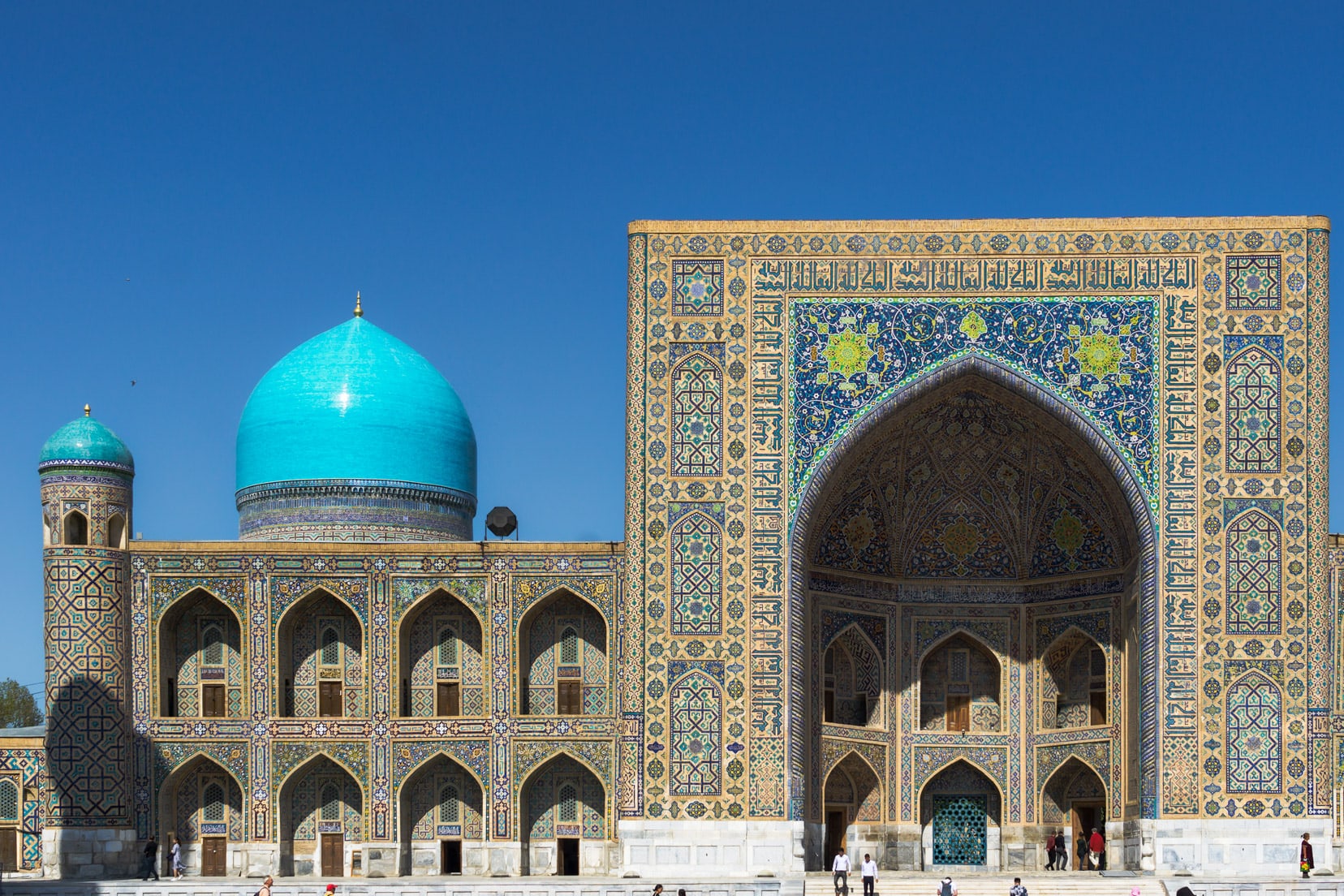
The madrasah’s ceilings are adorned with stunning motifs. It’s a visual masterpiece with such fine detail that it’s almost too much for the eye to take in.
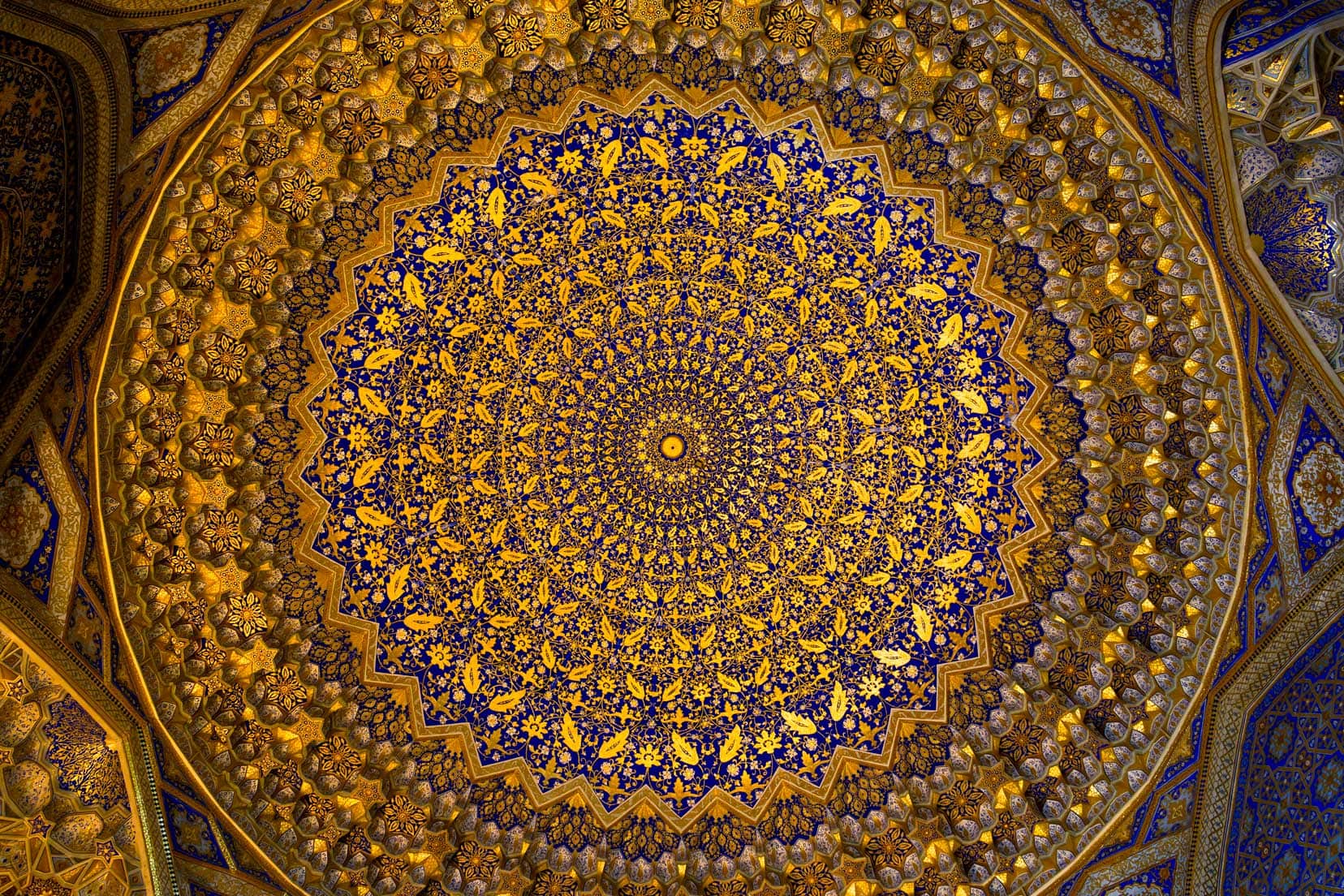
Islamic designs typically consist of repeated, overlapped, and interlaced squares and circles forming intricate and complex patterns. Islamic artists adhere to the belief that the creation of living beings is the work of God and should not be portrayed in artwork.
In lieu, common Islamic art patterns, geometric shapes, designs, and representations of flora or vegetation are used.
Passing through the front of the madrasah leads into an internal open-air courtyard. Here, many small retail shops are tucked away behind the massive earthen walls.
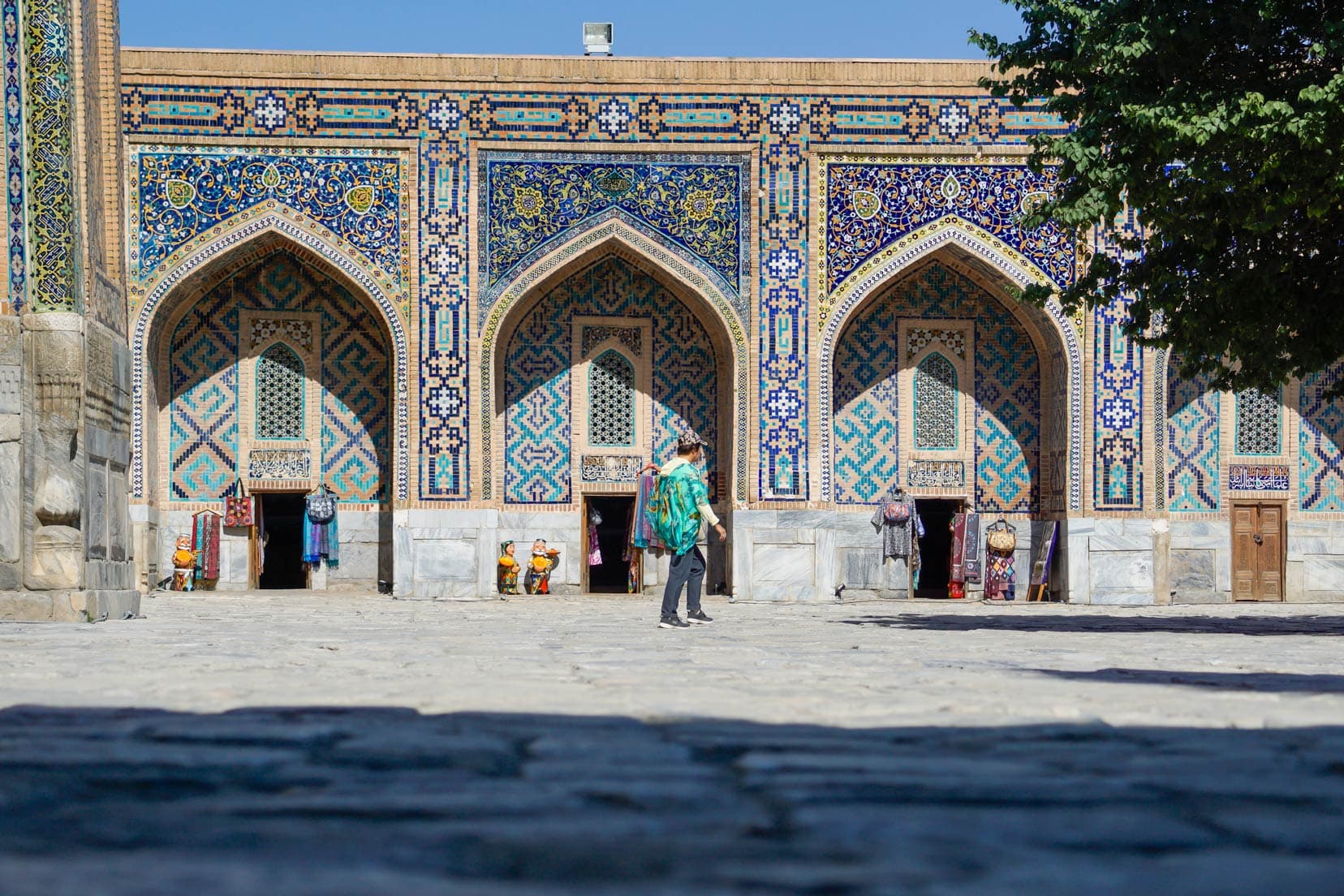
Vendors attempt to draw your attention with hellos and smiles, then beckon for you to ‘come inside’ and see their handicrafts, cashmere scarves, silk hats and ceramics displays. The sellers are not pushy, and a polite ‘no thanks‘ is enough to stop any further communication.

One shop definitely worth visiting is the Dil-Suzani Boutique.
The shop owner, Dilshod, is immediately upfront about not pushing a sale and then launches into an interesting talk about Uzbek history, traditions and the carpet trade. He is very knowledgeable about the history of Uzbekistan.
Pulling out different carpets, he proudly explains the symbolic meaning of the earth, wind and fire patterns on the material. He encourages you to take plenty of photos and ask all the questions you want without any further obligation.
Would you believe he also speaks eight languages fluently – and is self-taught?
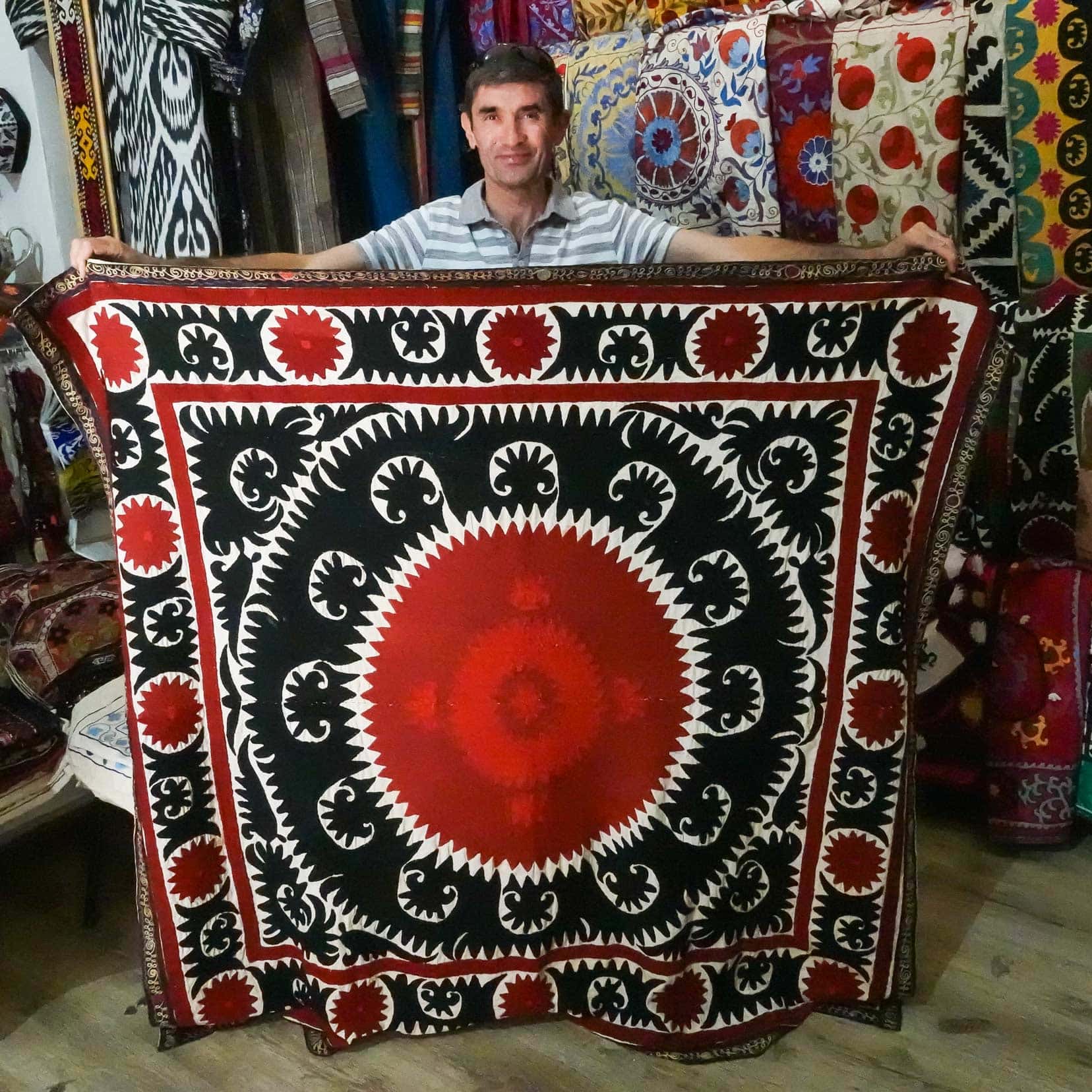
Sher-Dor Madrasah
The Sher-Dor madrasah (the one on the right when you enter Registan Square) was built to reflect the design of Ulughbel, the opposite madrasah.
The Sher-Dor portal represents a hunting scene with an animal from the cat family: a tiger with the mane of a lion, overseen by the beams of an ascending solar face.
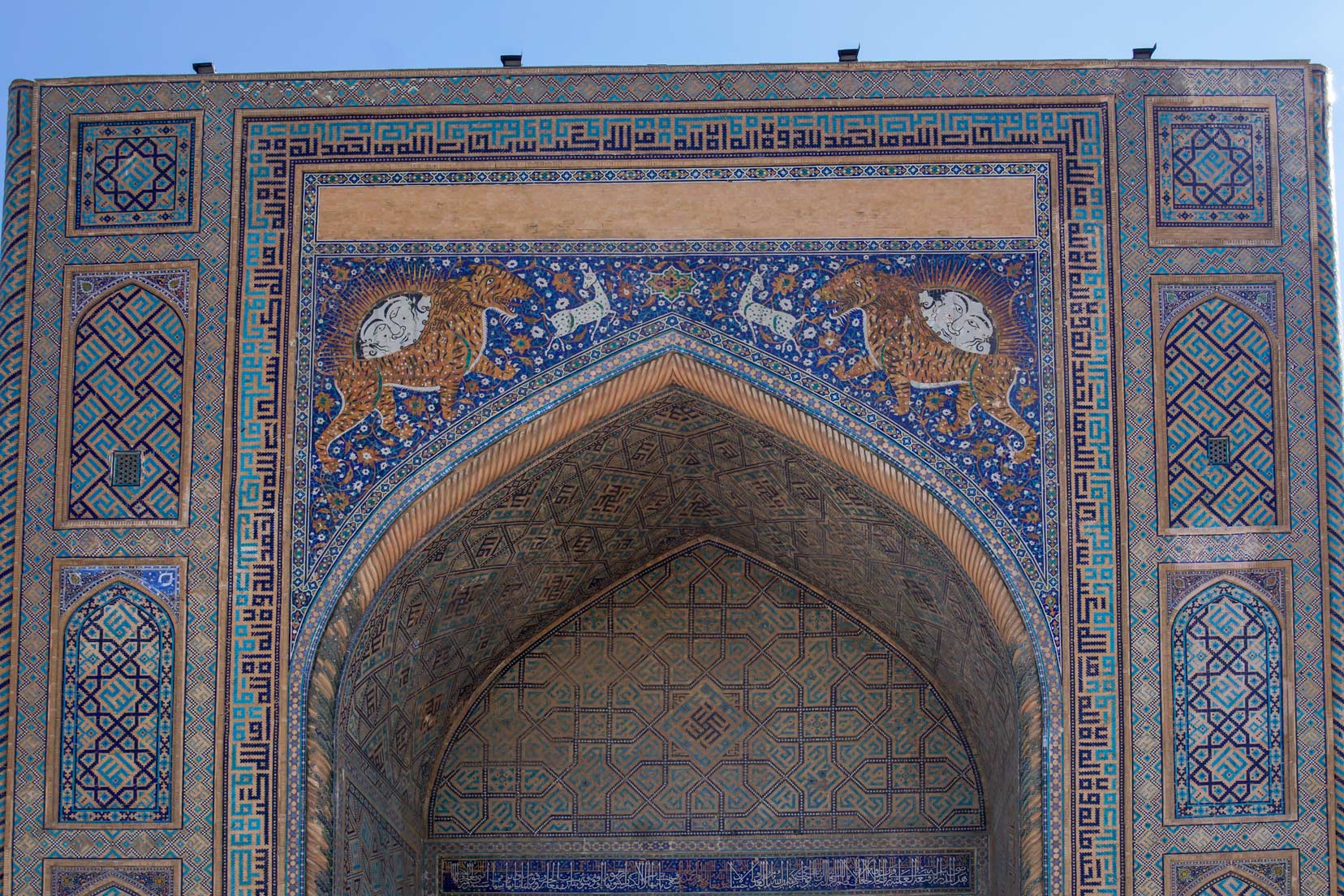
This depiction on the portal of Sher-Dor madrasah has been slowly adopted as one of the Republic of Uzbekistan’s national symbols.
All three madrasahs have suffered earthquake damage over the years. However, out of the three Registan Square madrasahs, Sher-Dor has undergone the most extensive restorations to repair earthquake damages.
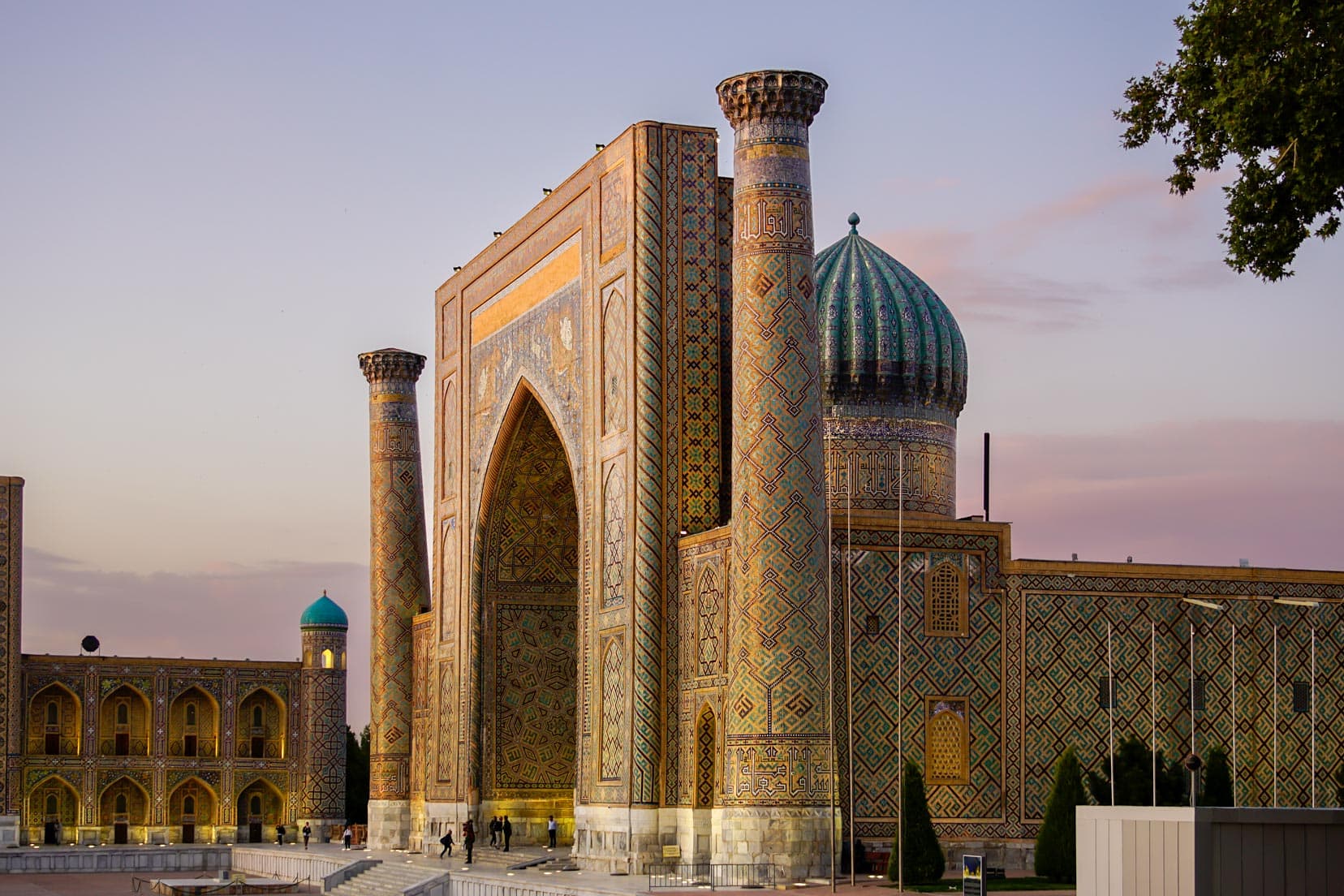
This madrasah also has retail shops within its courtyard but offers something a little different and a bit of fun. Traditional Uzbek dress-up garments can be hired, and then the person/s photographed.

Need some Uzbekistan tips? Our article below will help you out.

READ MORE: THE ULTIMATE UZBEKISTAN TRAVEL TIPS & GUIDE
2. Gaze at the Registan Square Light Show
The Registan Square light show is a highlight of the day when in Samarkand.
Mingle at Registan Square at dusk and await the magical laser light and sound show that follows. Colourful and lively imagery projected onto the different madrasahs portraying the 2750-year-old history of Samarkand.
The show really brings Registan Square to life. You don’t want to miss it.
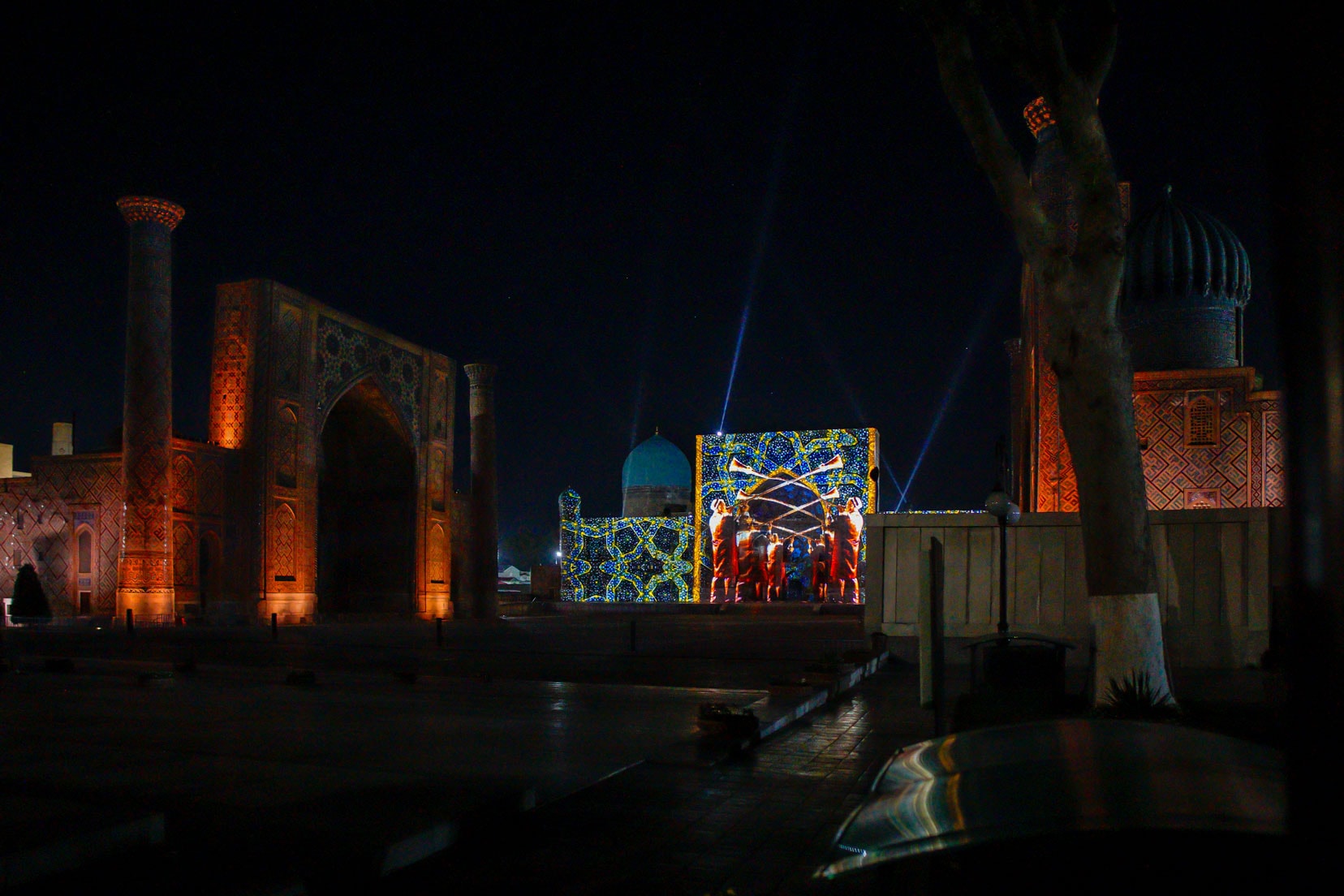
About Registan Square Light Show
The Registan Light Show time is 21:00 hours on a daily basis during the high season (June to August) and on special days such as the New Year, Nawruz (21st March), and Independence Day (01st September).
The theme is the same for each show, lasting for 20 to 30 minutes.
The best vantage point for viewing the Samarkand Registan light show is at the tiered concrete area behind Registan Square’s entrance.
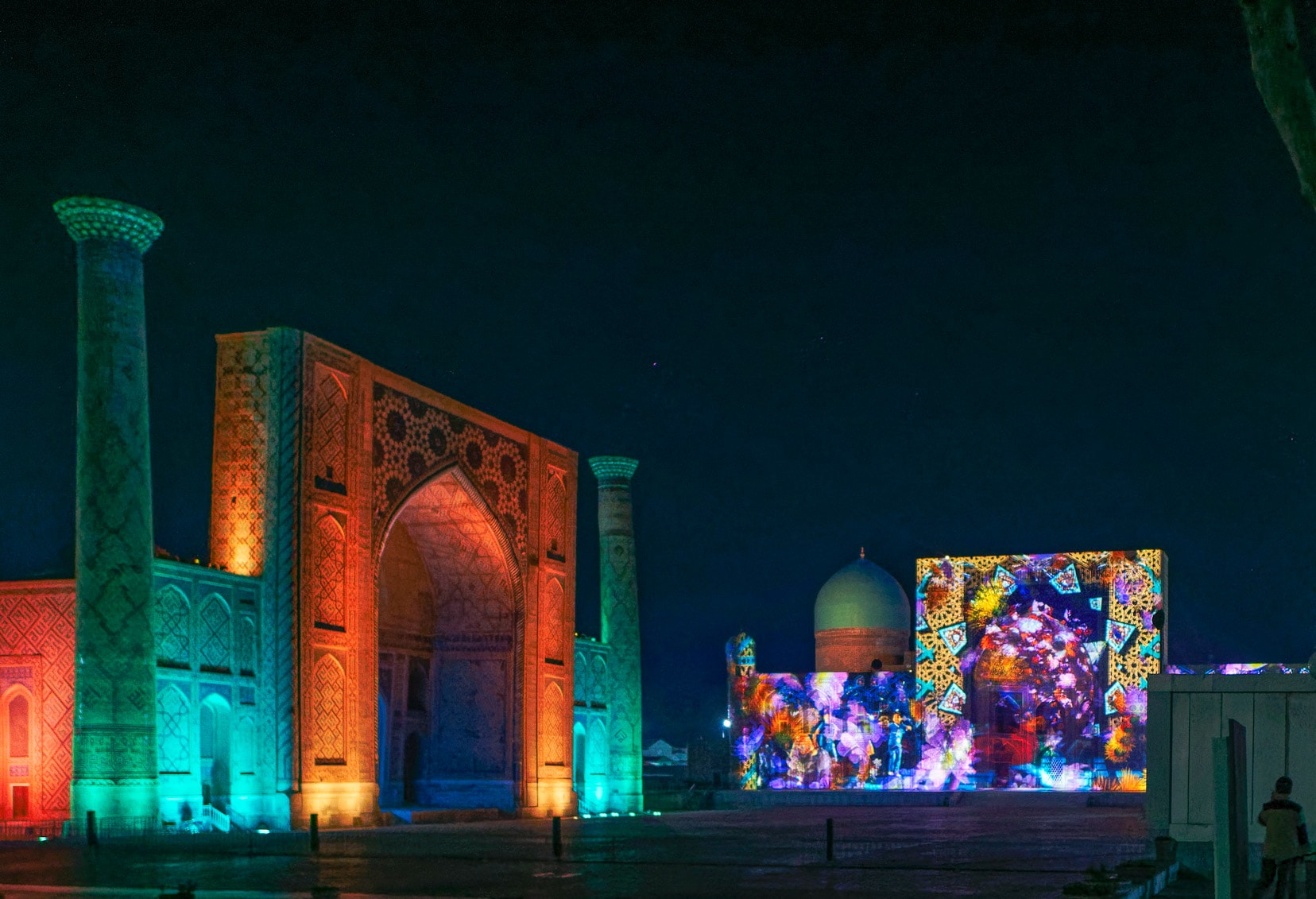
You will need to buy a separate ticket for the light show, which costs USD $8 per person. If you want to watch the lights without paying for a ticket, you can do so from outside the perimeter fence of the square.
Note: On offer are also 3D mapping light shows of 19 minutes duration, which are a special individual order. This is on an ad-hoc schedule, and really, it’s just down to sheer luck if you do manage to see one of these special shows. Here’s a YouTube link to the ‘special’ light show.
Below is a taster of the ‘standard’ light show. Whatever show it is, this Samarkand light show is a magical sight.
Registan Square Photography Tip:
Visit Registan Square close to sunset to witness the soft afternoon light spill over the madrasahs. After sunset, about 20 minutes of soft, natural light falls on the madrasahs before the bright, artificial lights are switched on to illuminate the square and surrounding structures.
This artificial lighting is turned off during the shows but remains on from sunset to 11 p.m.
Tilla Kari Park (just behind Registan Square) also offers some interesting perspectives and lighting of Registan Square at night.
3. Take a Samarkand Tour
If you’re keen to explore Samarkand’s rich tapestry but are short on time or prefer a guided experience, taking a tour is a fantastic option.
With a knowledgeable guide, you’ll get insider access to hidden gems and historical anecdotes that you might miss on your own. Plus, it’s a stress-free way to navigate the city and cultural nuances.
Here are a few options:
🍷 Samarkand Wine Tasting Tour | ⏳ 2 hours | ⭐️ 4.5 star reviews | Check price and availability
🌆 Samarkand City Tour | ⏳ 7-9 hours | ⭐️ 4.5 star reviews | Check price and availability
🏙️ Samarkand city history, architecture and the culture tour | ⏳ 4-5 hours | ⭐️ 4.5 star reviews | Check price and availability
👣 Explore Samarkand as a local | ⏳ 2 days | Check price and availability
4. Samarkand Tourist Information Center
Why include a tourist info centre on our list? The staff here are really knowledgeable and just so helpful. It’s worth a stop early in the day to ask if something special may happen on the day or something of interest you haven’t accounted for in your plans.
To find the tourist information centre from Registan Square, walk a kilometre northeast down Islam Karimov Street, past the ATMs and shops.
The staff here were so helpful that they even joined us at the local bazaar, helping to find some needed footwear. How thoughtful.
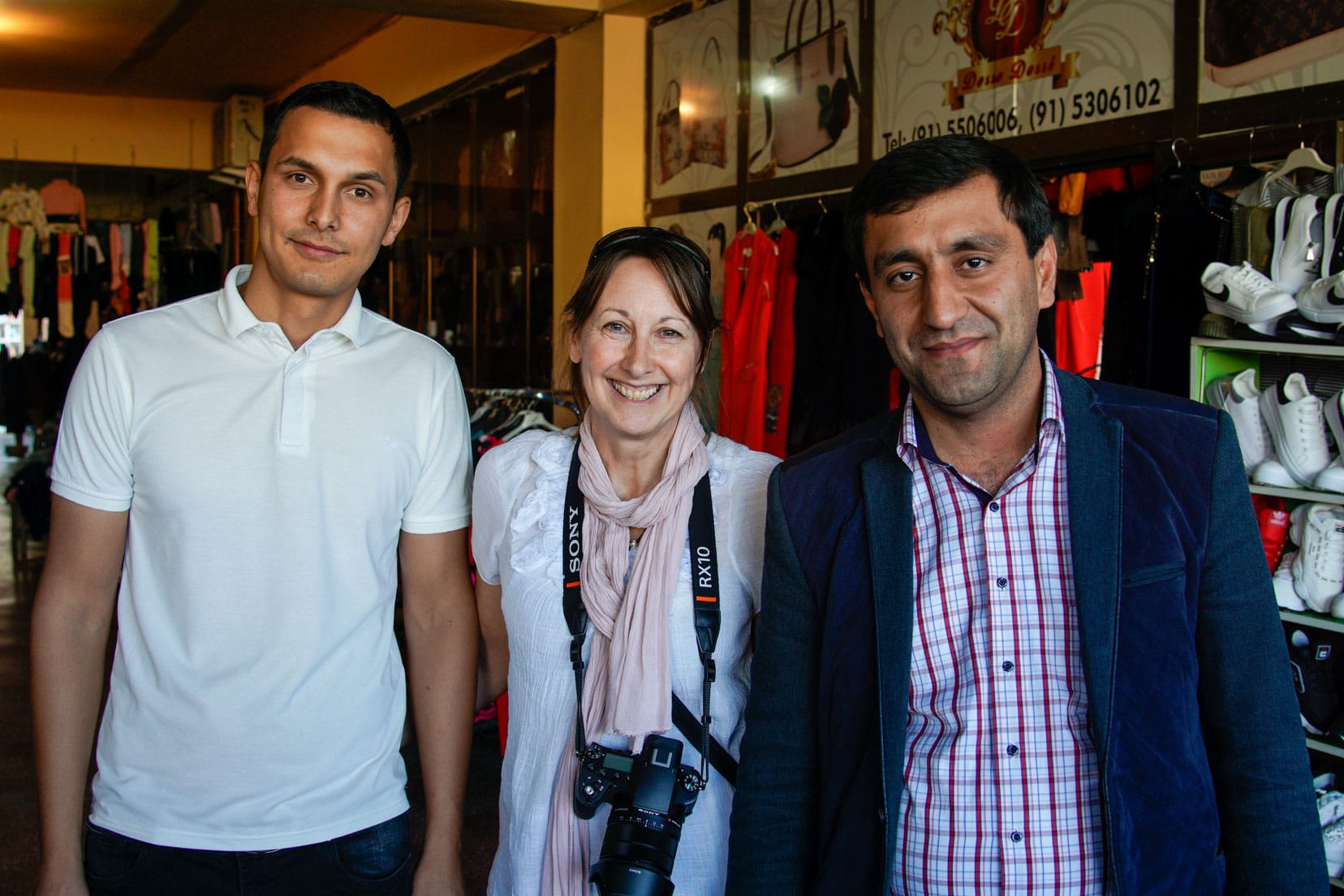
5. Bibi Khanym Mosque
A short 15-minute walk from Registan Square brings you to the Bibi Khanym Mosque. This massive congregational mosque, a rectangular 167m by 109m, is able to hold 10,000 worshippers.
The Bibi Khanym mosque was built between 1399 and 1404 A.D. by Timur, the undefeated imperial ruler at the time, in memory of his wife. This mosque compound is unique in the Islamic world, comprising three separate domed units.
Construction stopped in 1405 when Timur suddenly died. However, the Bibi-Khanym Mosque remained in use until the 17th century, after which the Tilla Kori Mosque was built as a replacement.
During the 1970s, the Soviets began massive restoration works to repair earthquake damage.
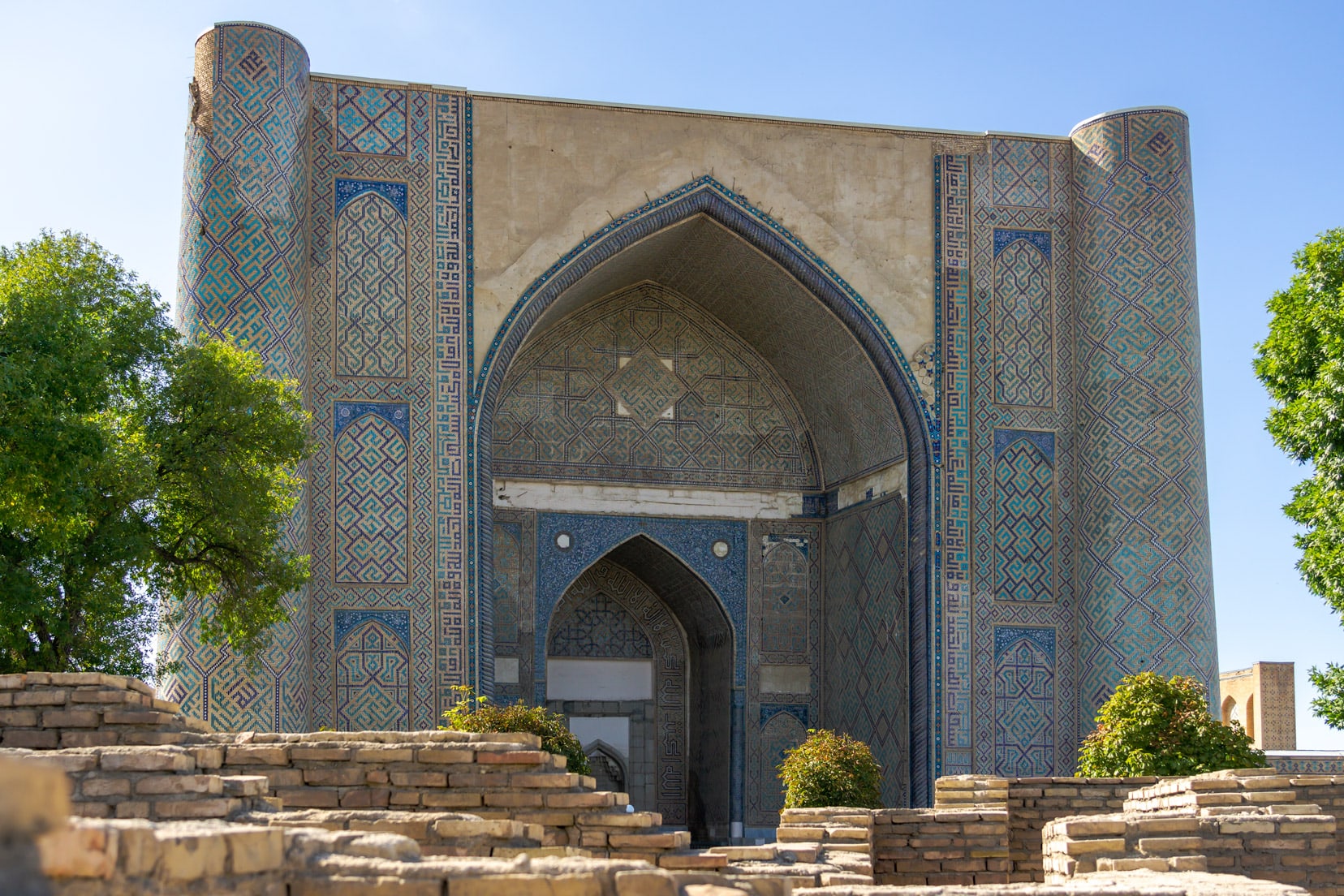
6. Bibi Khanym Mausoleum
The Bibi Khanym mausoleum lies opposite the Bibi Khanym mosque and houses three sarcophagi. It is said that the mausoleum was built in honour of Bibi Khanym’s mother, who was reputedly the first to be buried inside.
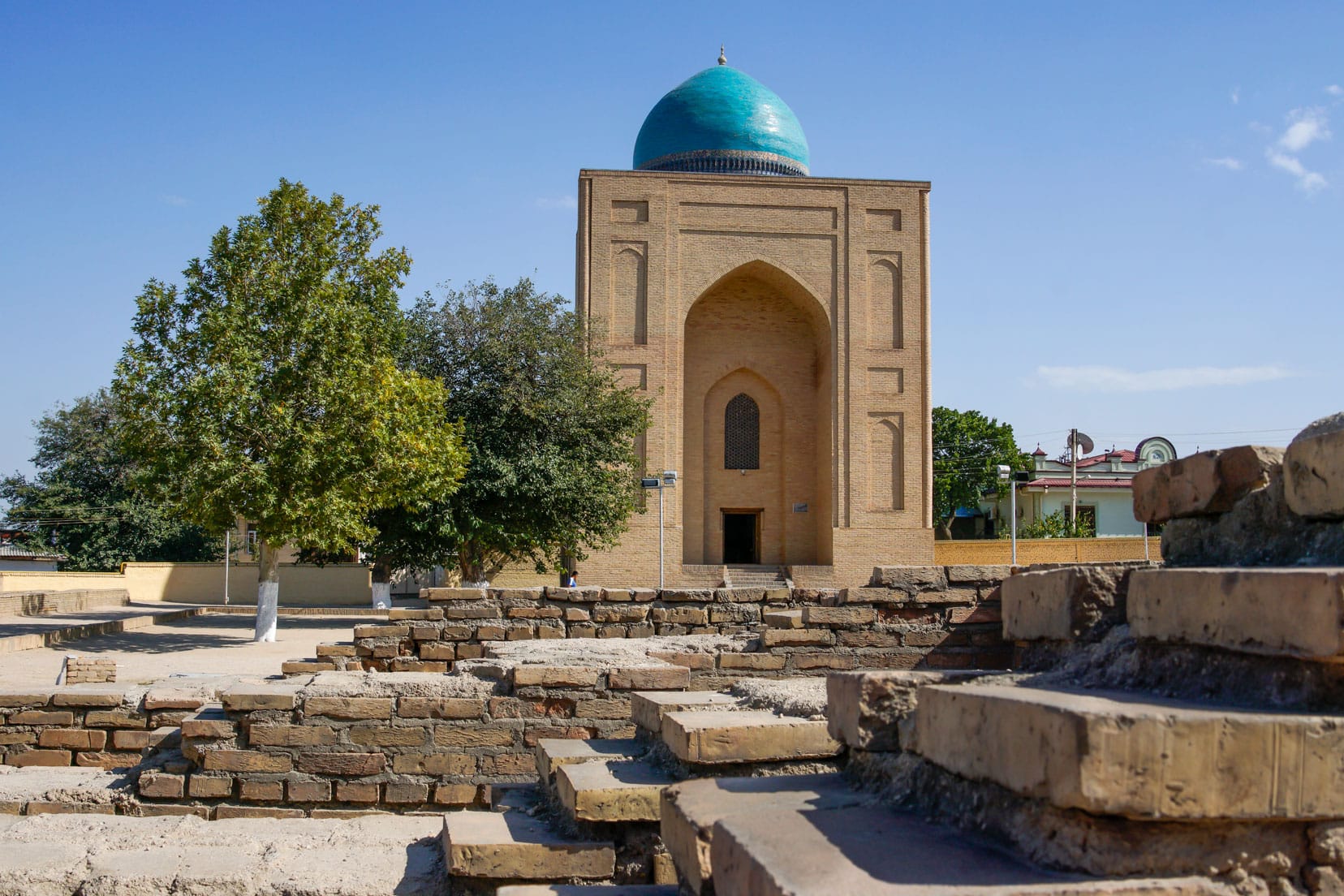
Nothing is actually known about the burial of Bibi Khanym, wife of the then-imperial ruler Timur. Where she is buried, or the ceremony marking her departure, remains a mystery.
It is surmised that the Bibi Khanym mausoleum may be a burial place for women and that the other two sarcophagi are likely female family members of Bibi Khanym.
7. Siab Bazaar
Skirting the boundary of Bibi Khanym Mosque brings you to Siab Bazaar, an agricultural market selling mostly fruit and vegetables. The main entrance is a fancy 3-arched portal.
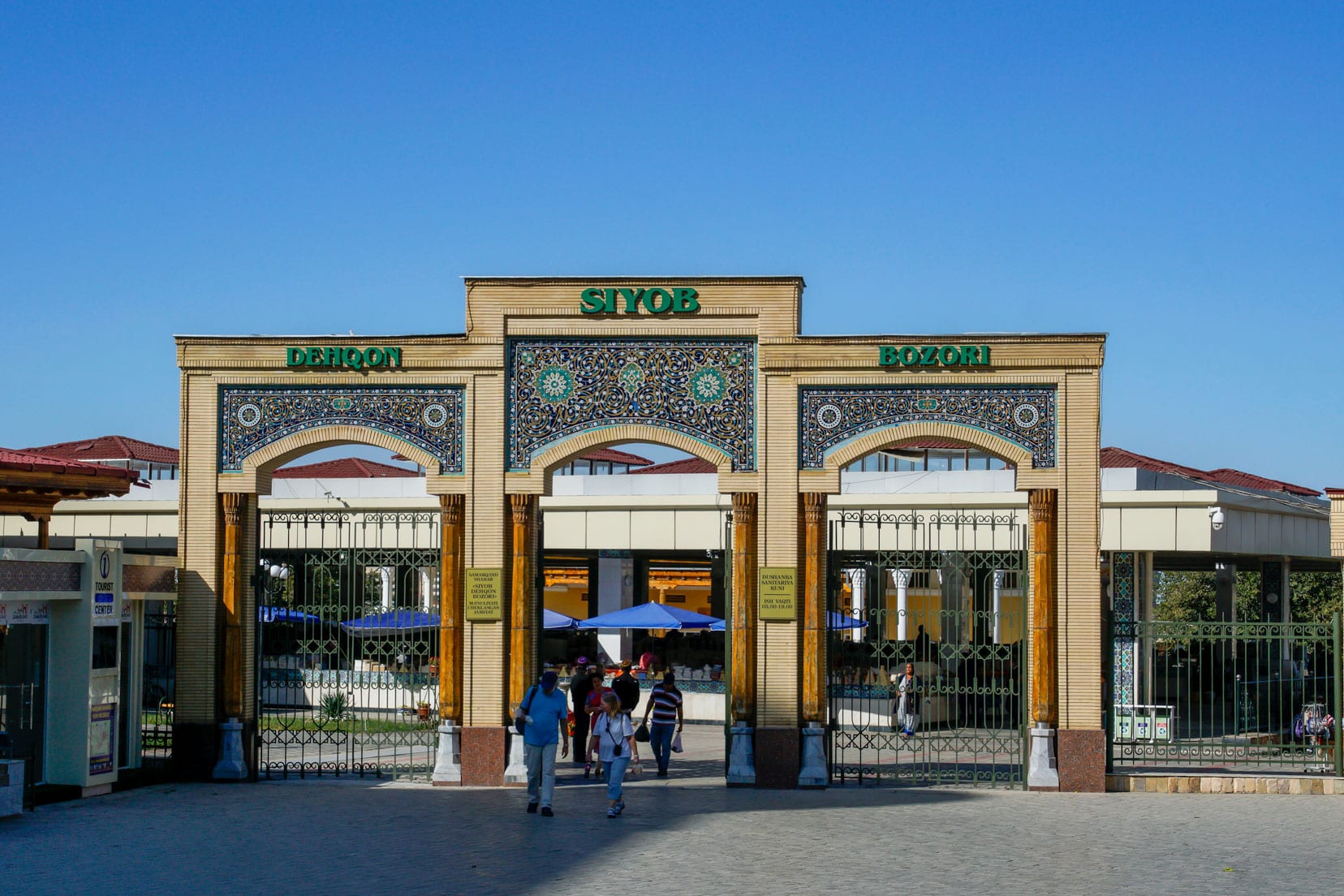
Also on offer are a wide array of spices, homewares, local works of art and the special hot bread. The bread, and there are a lot of different types sold at the bazaar, is made of a special local flour product. We thought the bread was very tasty.
It’s a cheery venue with vendors happily gesturing for you to try their produce. As with most markets, mornings are when you’ll see the market at its best and in full swing.

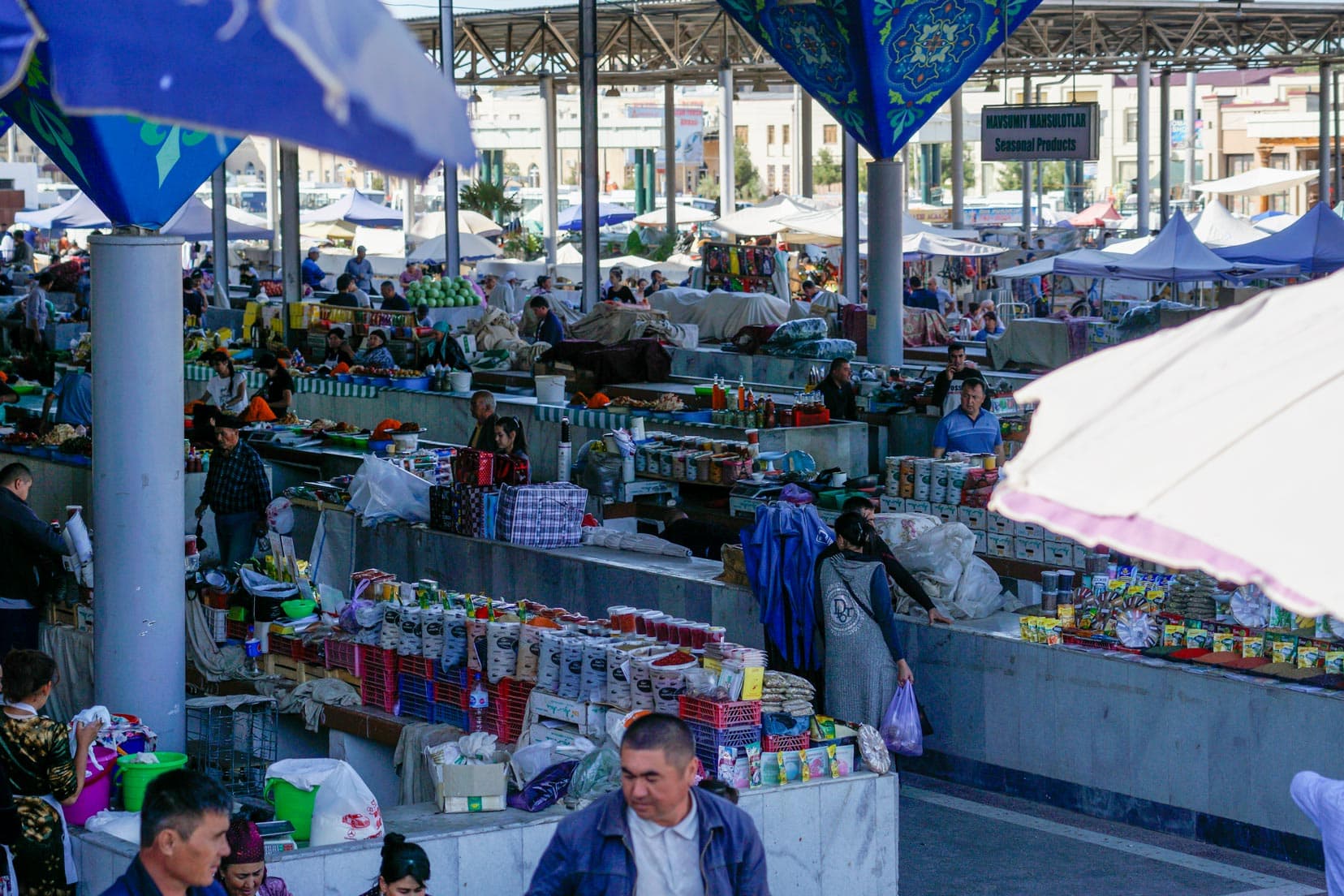
8. Shah-I-Zinda Cemetery
The Shah-I-Zinda cemetery has a vast array of modern gravesites, with an exclusive interior section of historical mosaic tombs and mausoleums known as the Shah-I-Zinda complex.
The modern gravestones close to the main paved cemetery paths, with their lofty views, are often ostentatious.
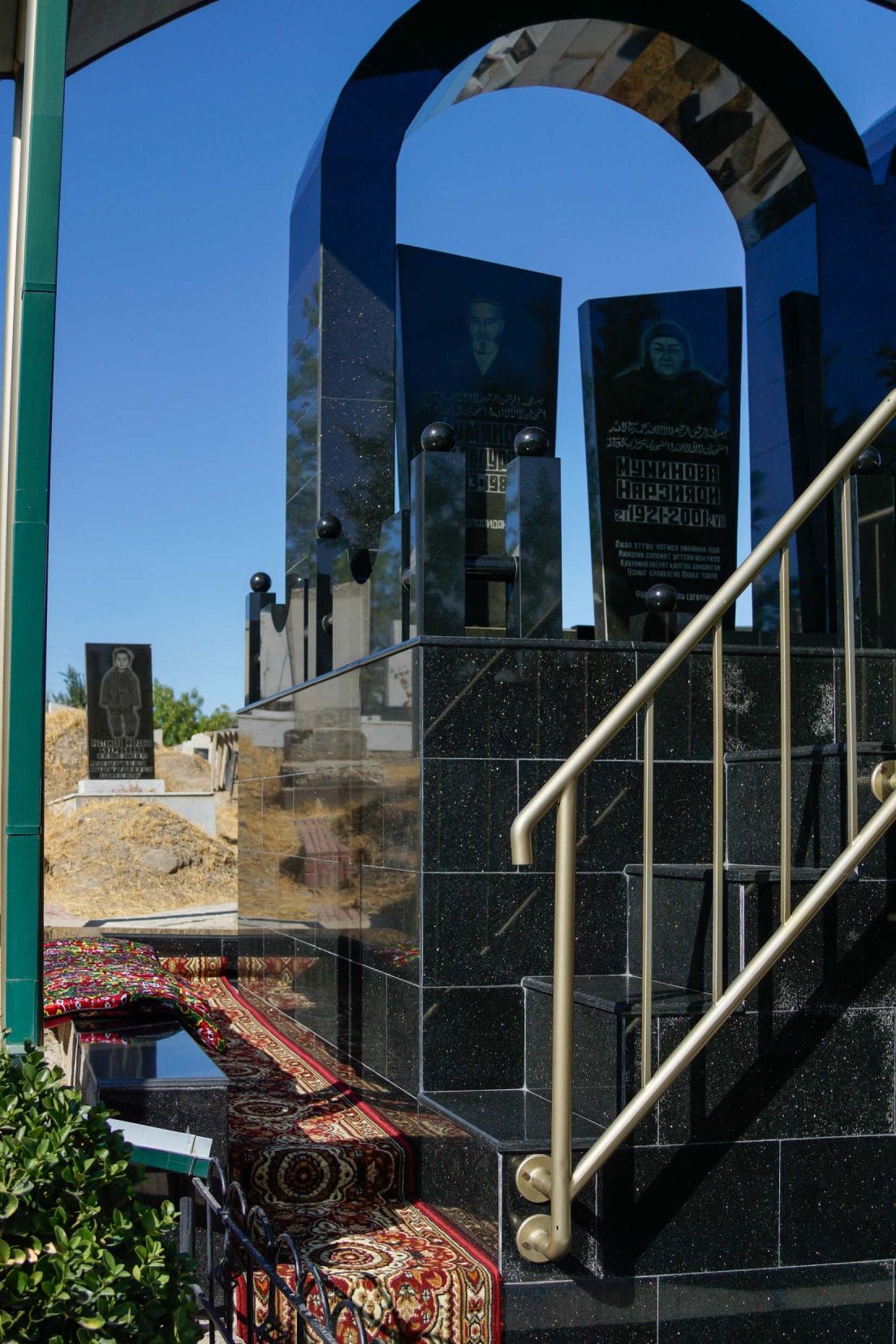
In stark contrast, the lower-sited gravestones in the poorer parts of the cemetery are much plainer. The main reason to walk through this cemetery is to access the Shah-i-Zinda complex; however, the cemetery walk itself, to see these lavishly appointed headstones, is quite interesting.
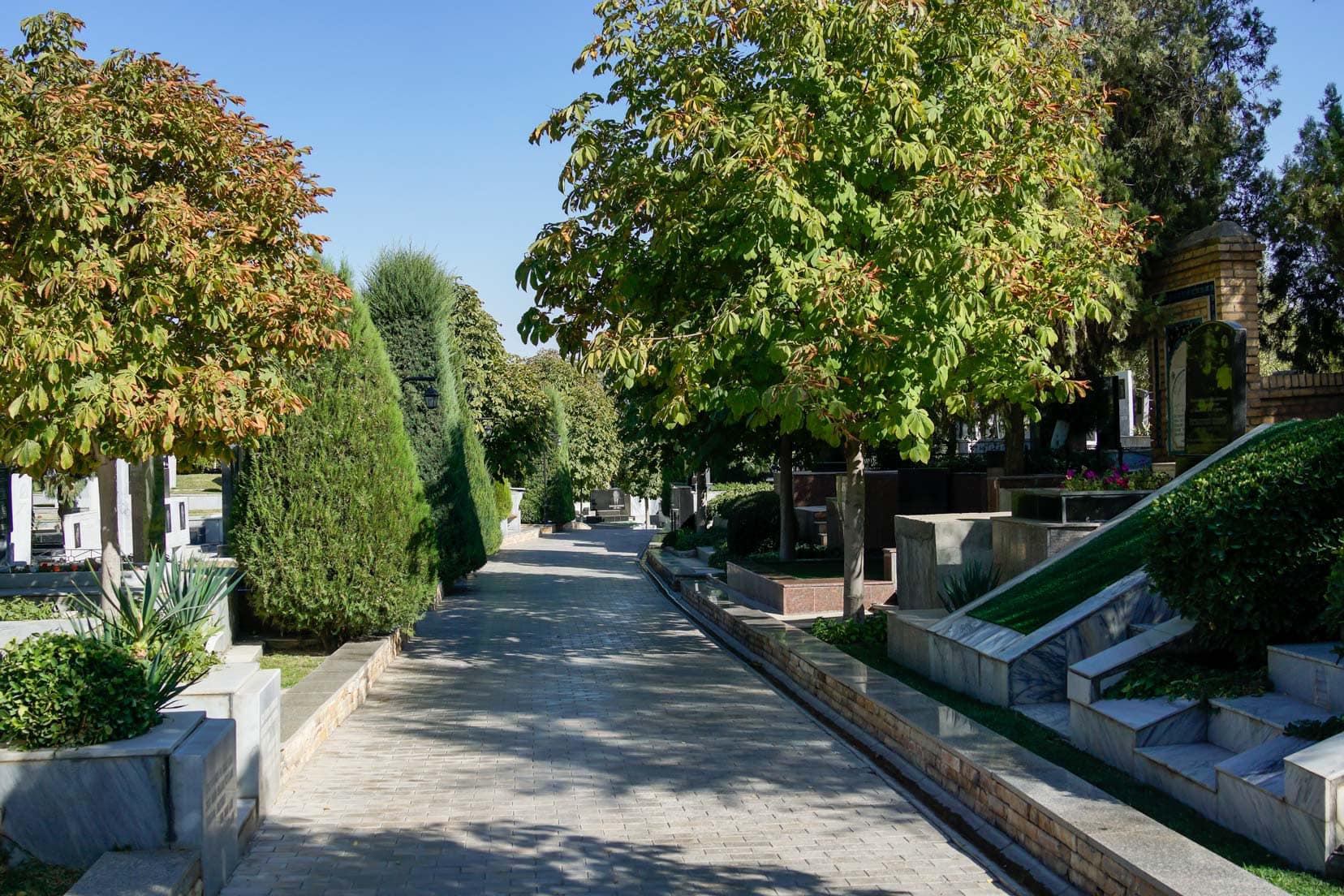
If you’ve chosen to walk the cemetery paths, you can catch views of the next stop, Samarkand’s beloved Shah-I-Zinda necropolis.

9. Shah-I-Zinda Necropolis
The Shah-i-Zinda necropolis (sometimes called the Zinda Necropolis) consists of an avenue of more than twenty richly appointed tombs and mausoleums of the nobility.
As the story is told, this site was founded to honour the original burial place of Prophet Muhammed’s cousin, Qusam.
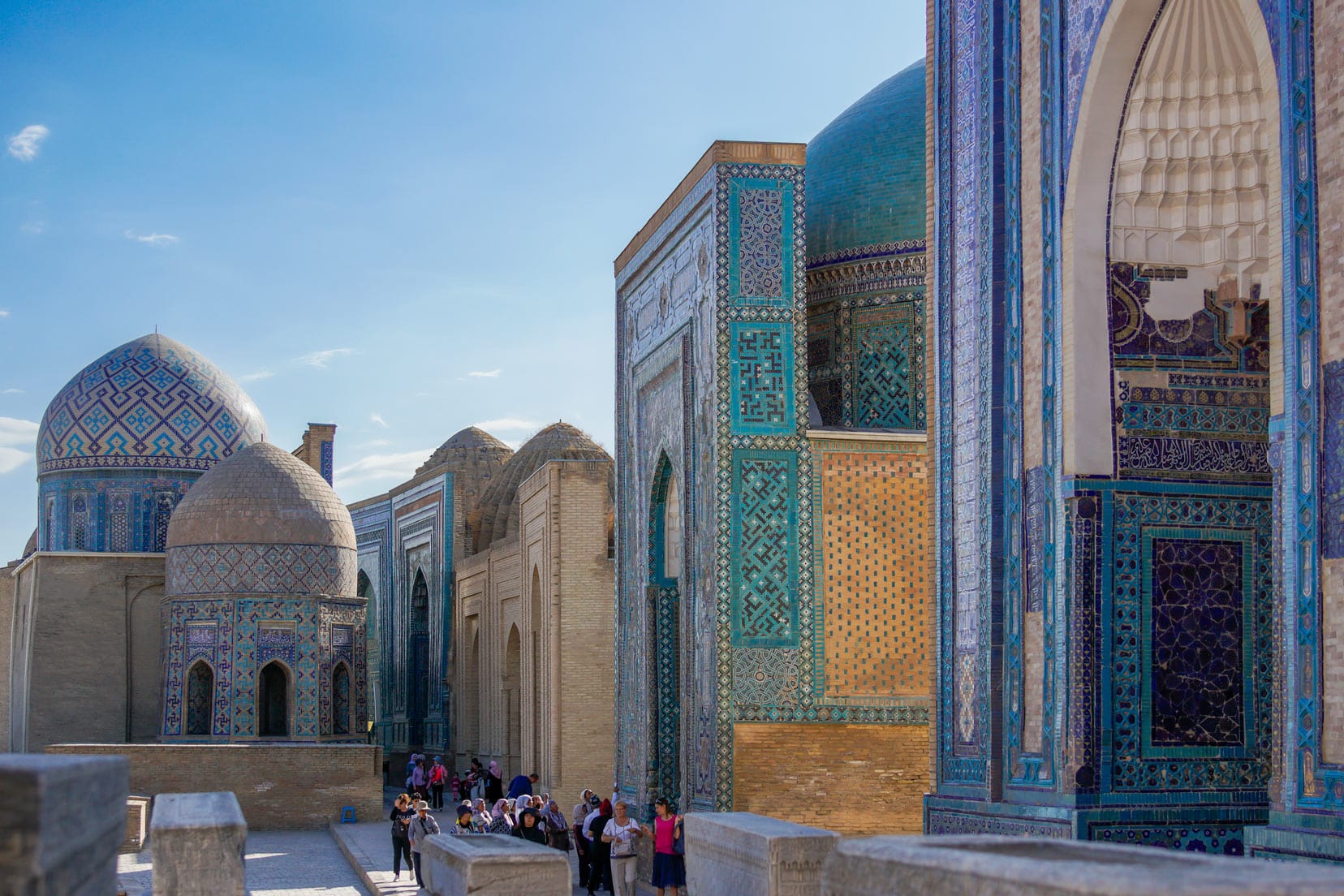
Shah-i-Zinda translates to ‘Tomb of the Living King’, in reference to the holiest shrine in the necropolis and what is widely reputed to be the grave of Qusam ibn-Abbas, who, in the 7th century, introduced Islam to the area.
This necropolis is so special because the various mausoleums, temples and buildings were continually added between the 11th and 19th centuries, a span of about 1000 years. This has resulted in an intriguing and spectacular mix of decorative craftsmanship and architectural styles.
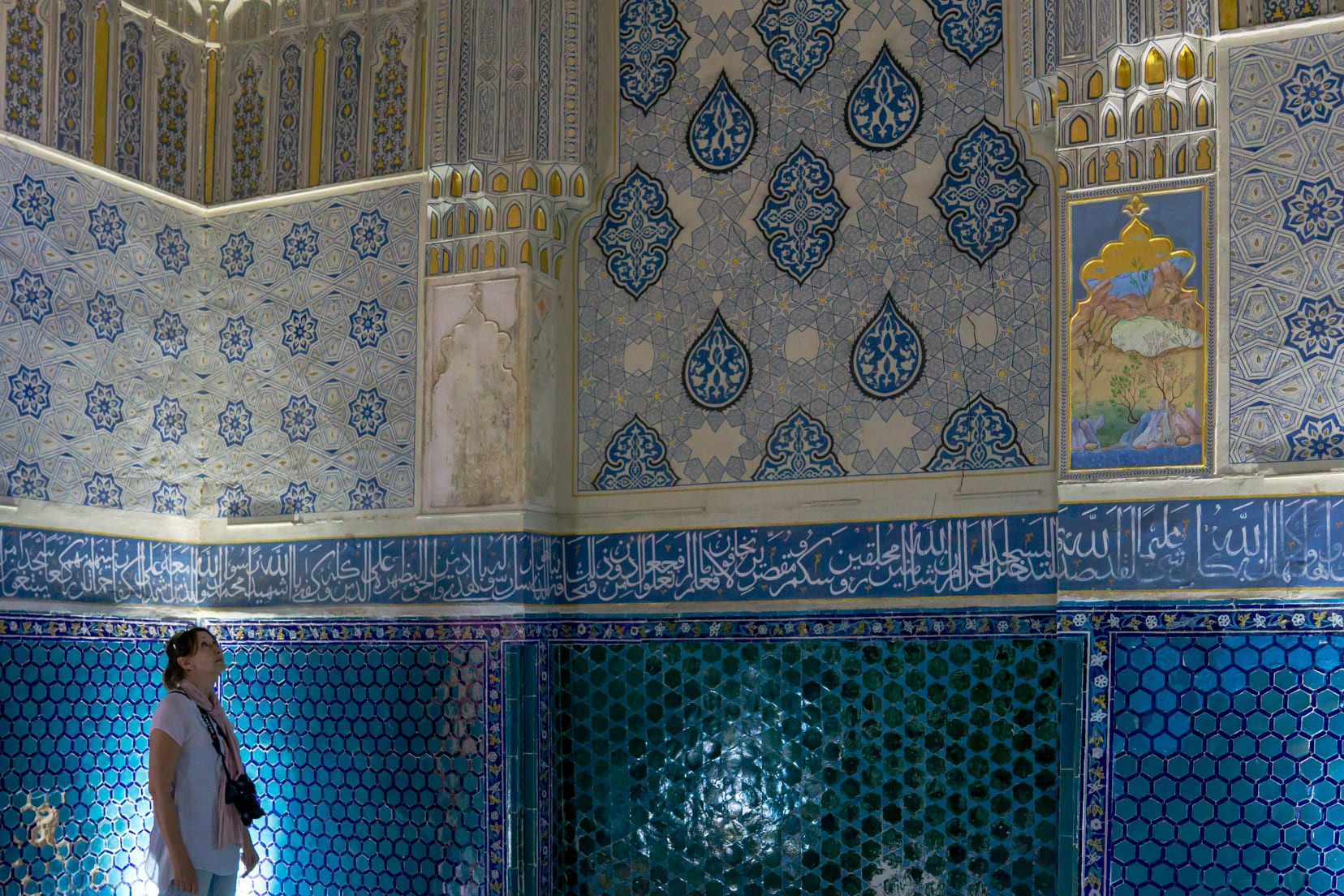
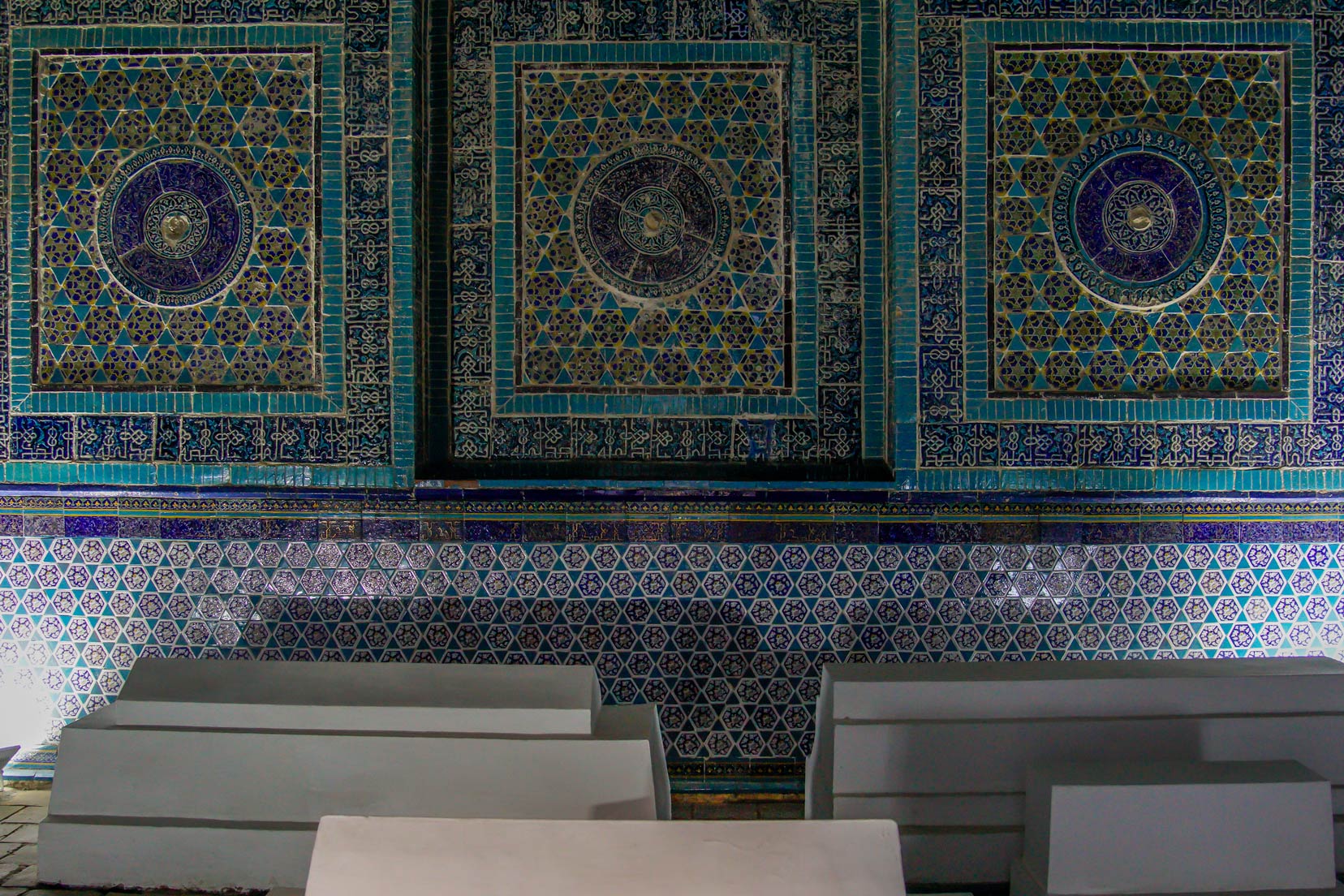
These structures are tightly packed together, towering over the paths connecting them. Steps lead into the mausoleums, giving limited access to the space but enough to see the boggling array of exquisite colours and mosaics that adorn the ceiling and walls.
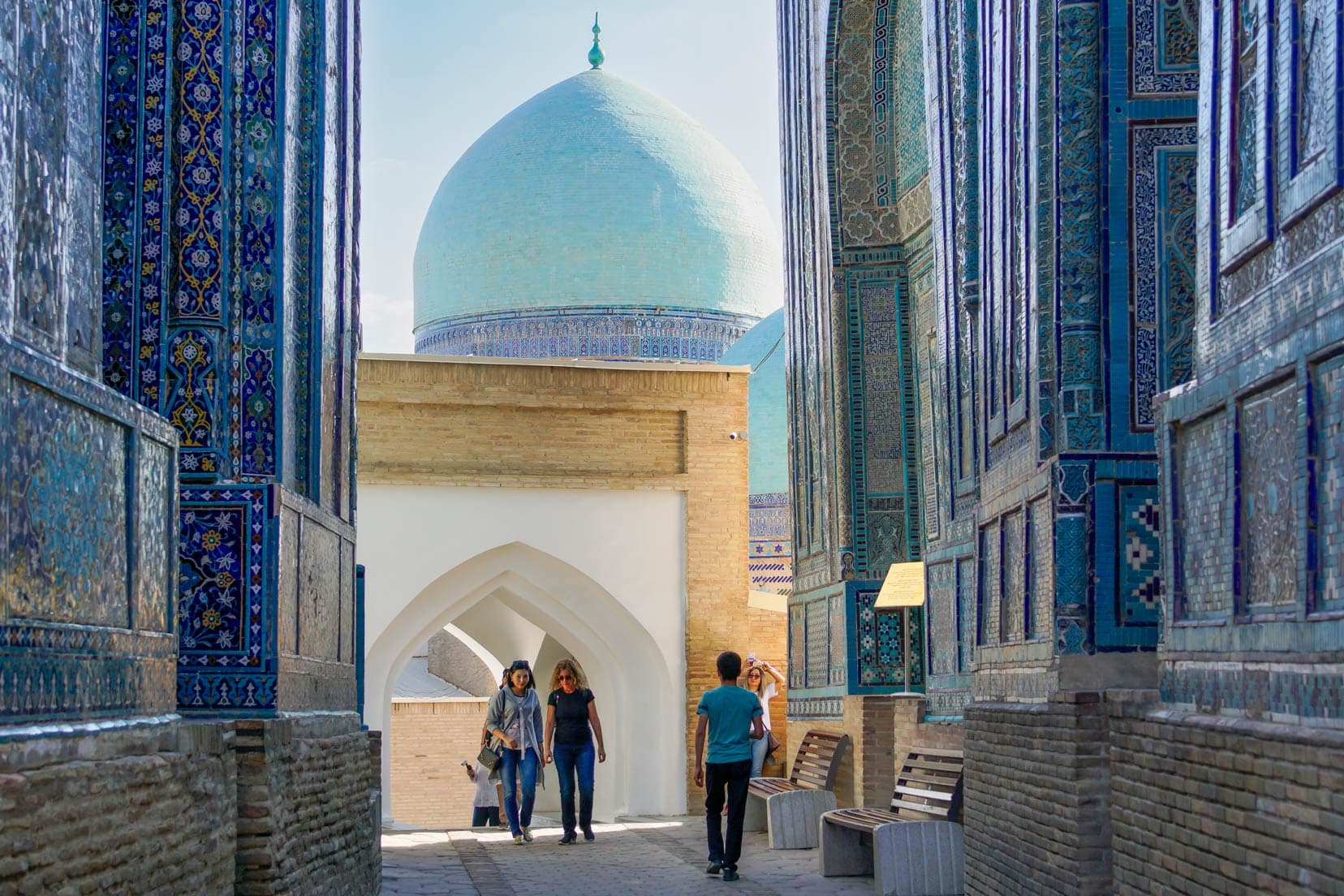
In 2005, under heavy controversy, many of the tombs in Shah-I-Zinda underwent extensive restoration, permanently altering the originality of the tiles and mosaics. Regardless, it still remains a must-see attraction in Samarkand.
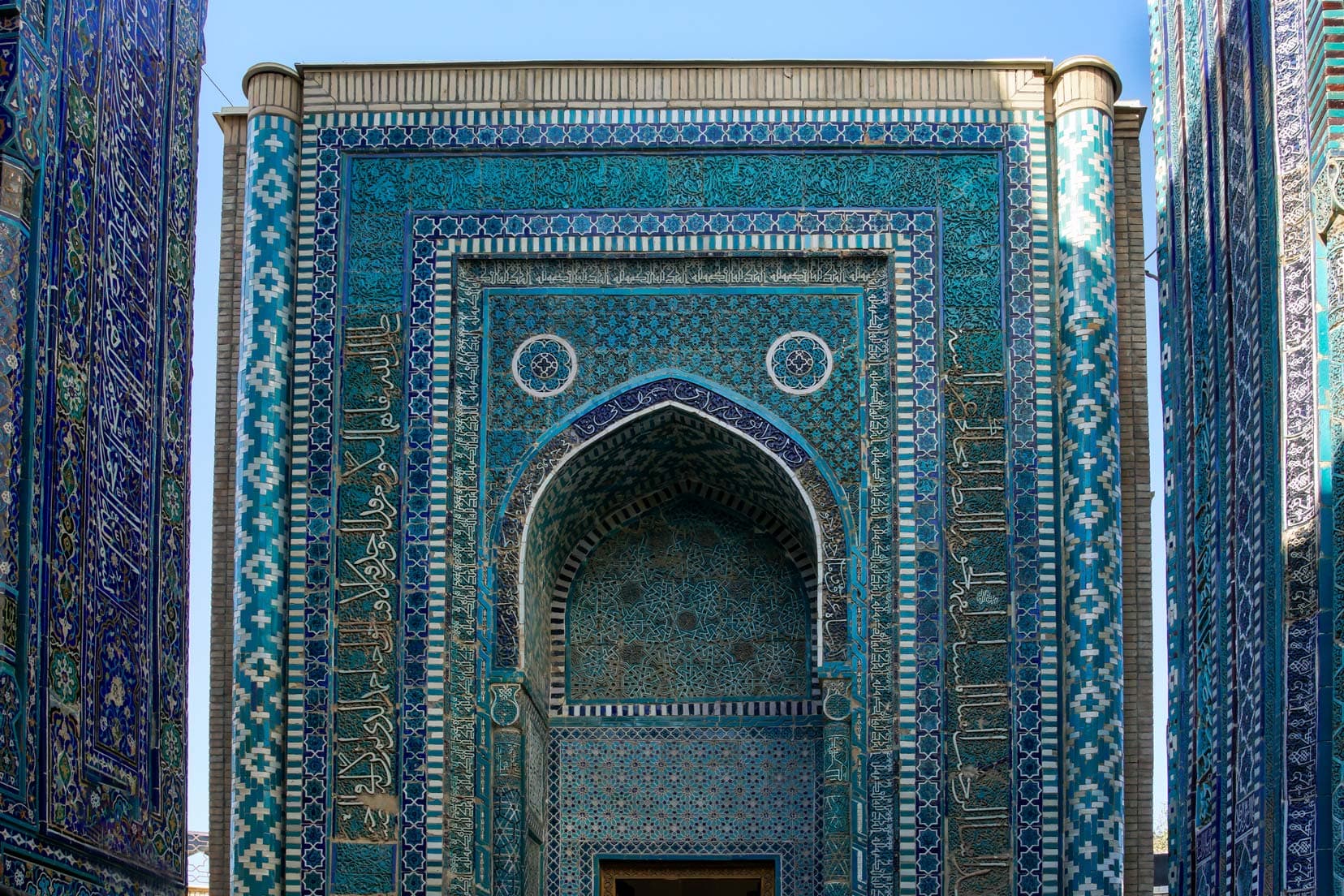
Entry into the Shah-I-Zinda necropolis will cost SOM 15,000 per person (USD $1.20) plus an extra SOM 10,000 to take photographs.
Shah-I-Zinda’s opening times are between 7 am and 7 pm.
Note that strict rules must be observed when entering this reverent place. The below image is posted at the entrance to the necropolis.
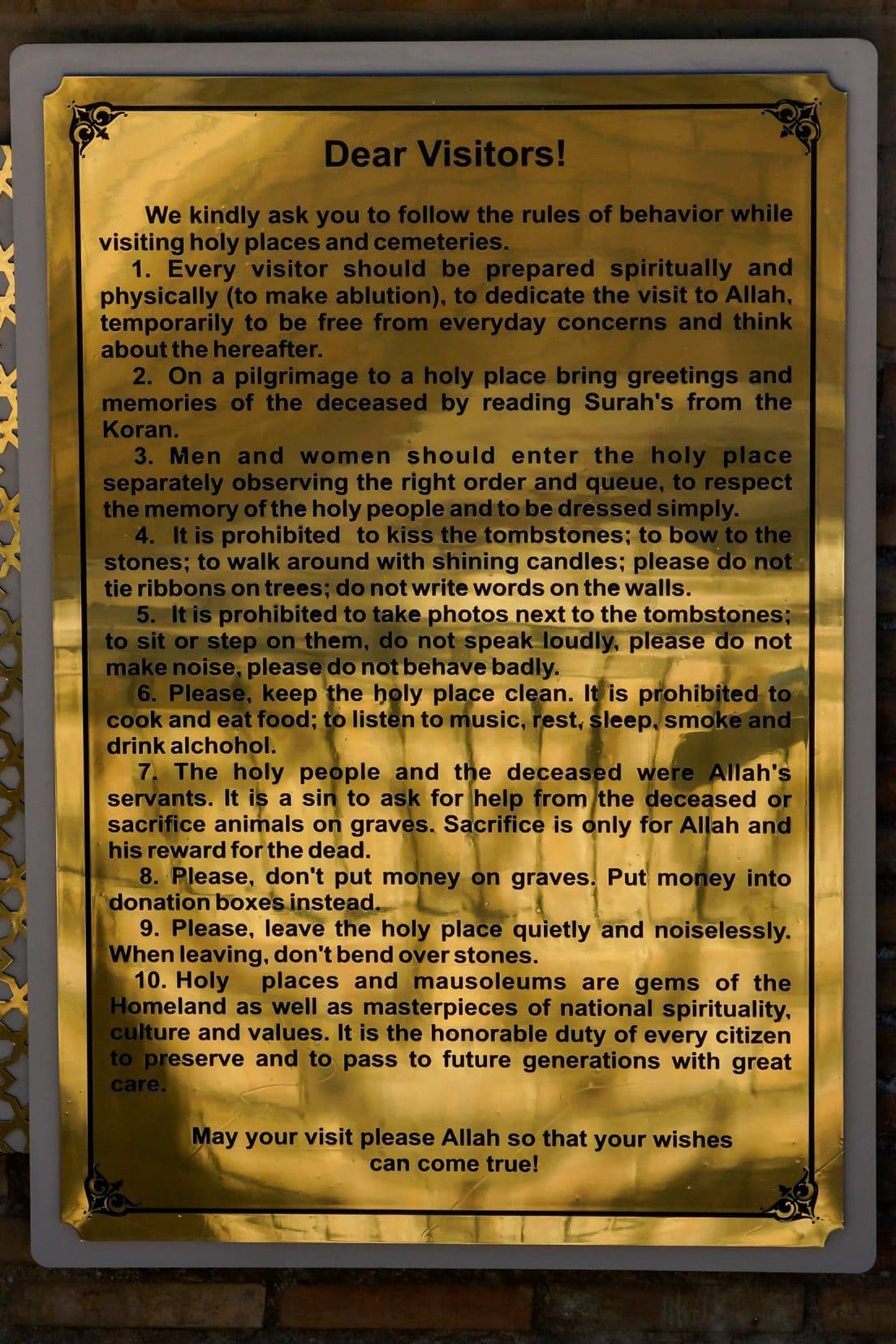
10. Amir Temur Mausoleum Gur-i Amir Complex
About one-kilometre southwest of Registan Square lies the Amir Temur Mausoleum Gur-i Amir Complex. This is the burial place of Amir Timur (died 1405 A.D.), the revered conqueror of central Asia. Also buried here are his two sons, two grandsons, and Amir’s spiritual mentor.
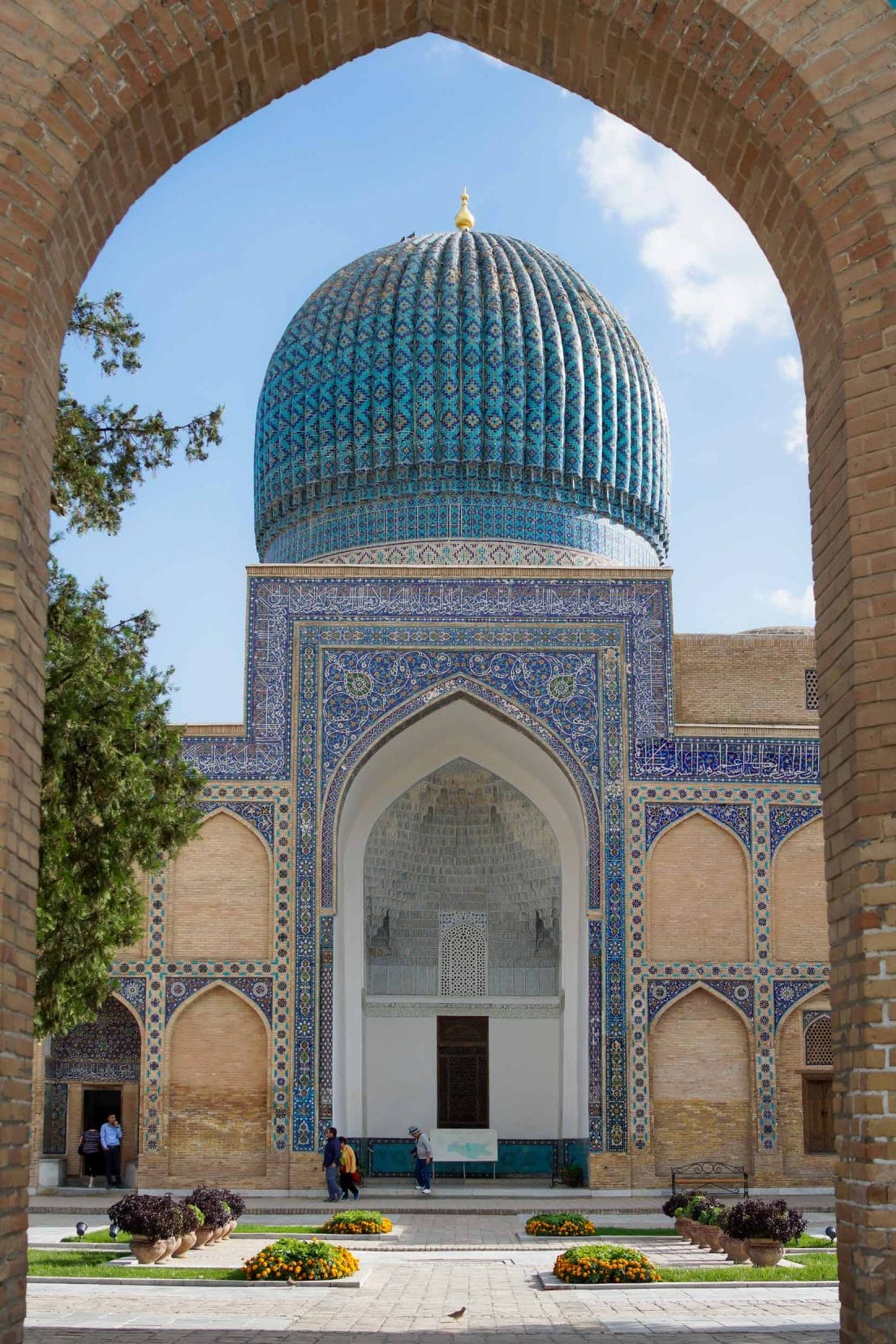
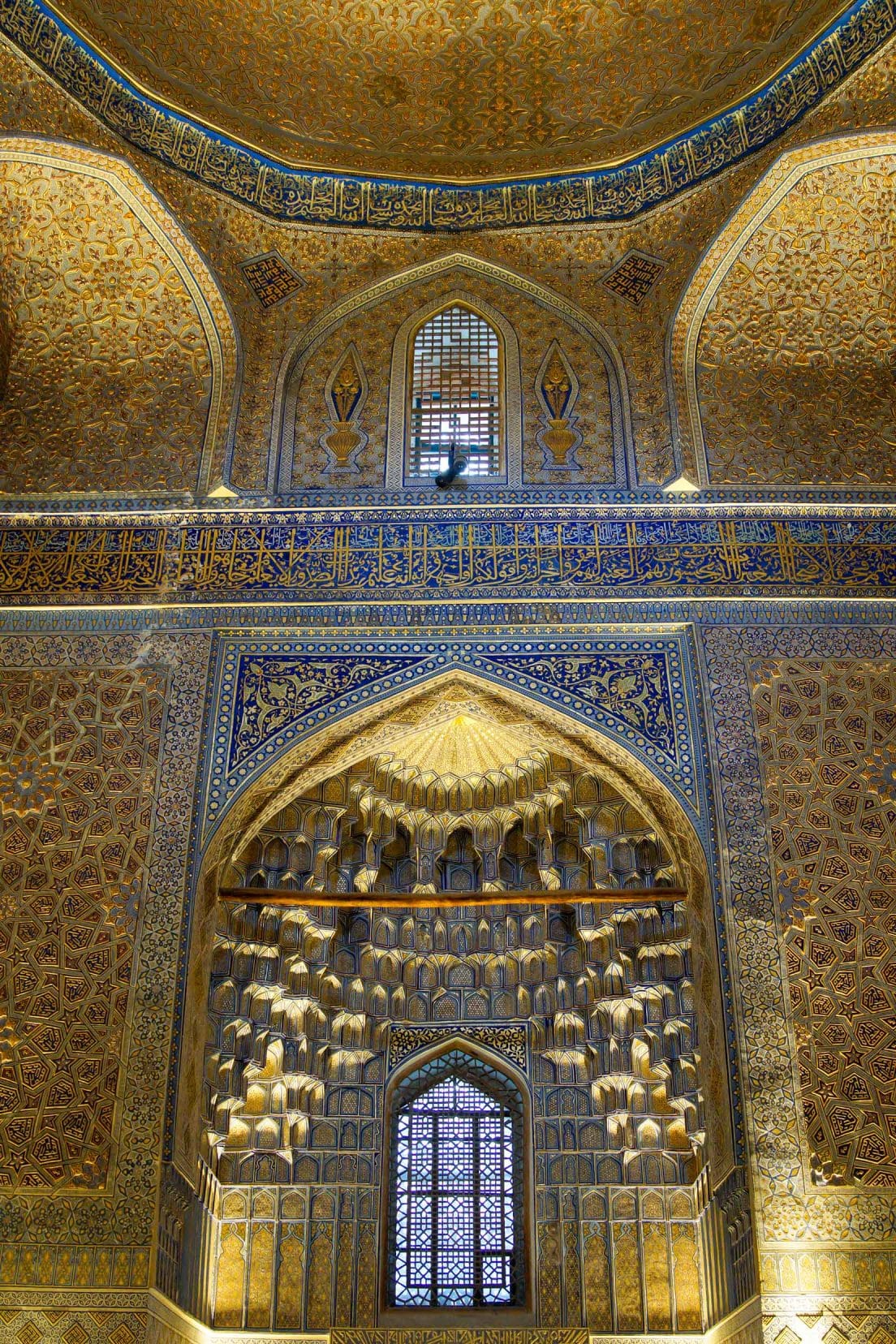
Amir Temur’s coffin is unique in that it has a covering of a single piece of black jade.
History states that Amir wanted to be buried at Shahrisabz (85 kilometres from Samarkand), where he already had a waiting tomb. Instead, he was buried in Samarkand as the mountain passes between the two would not allow passage in winter.
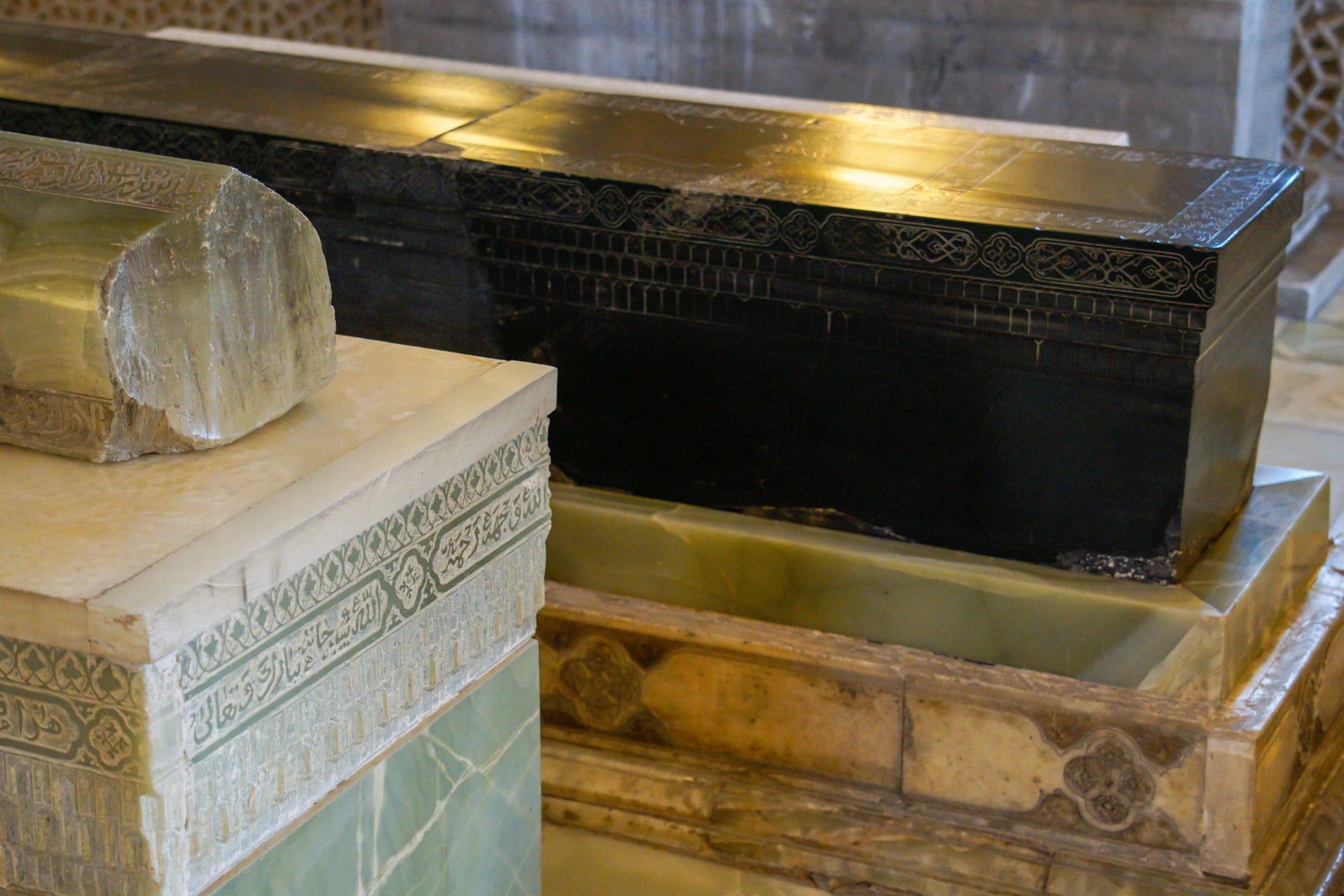
A little bit of trivia:
In June of 1941, Russian scientists made the decision to open the grave of Timur against the wishes of the Uzbek people, who warned that only ill would come of it. As fate would have it, two days later, Germany began the invasion of Russia.
11. Amir Temur Statue
Crossing into University Boulevard, a few hundred metres away, is the giant-sized statue of Amir Temur.
It’s a busy roundabout, but you can cross over with the traffic lights if you time it right.
Due to the statue’s sheer size, we found the best vantage point for photos was right opposite the statue in Hamid Alimjan Park.
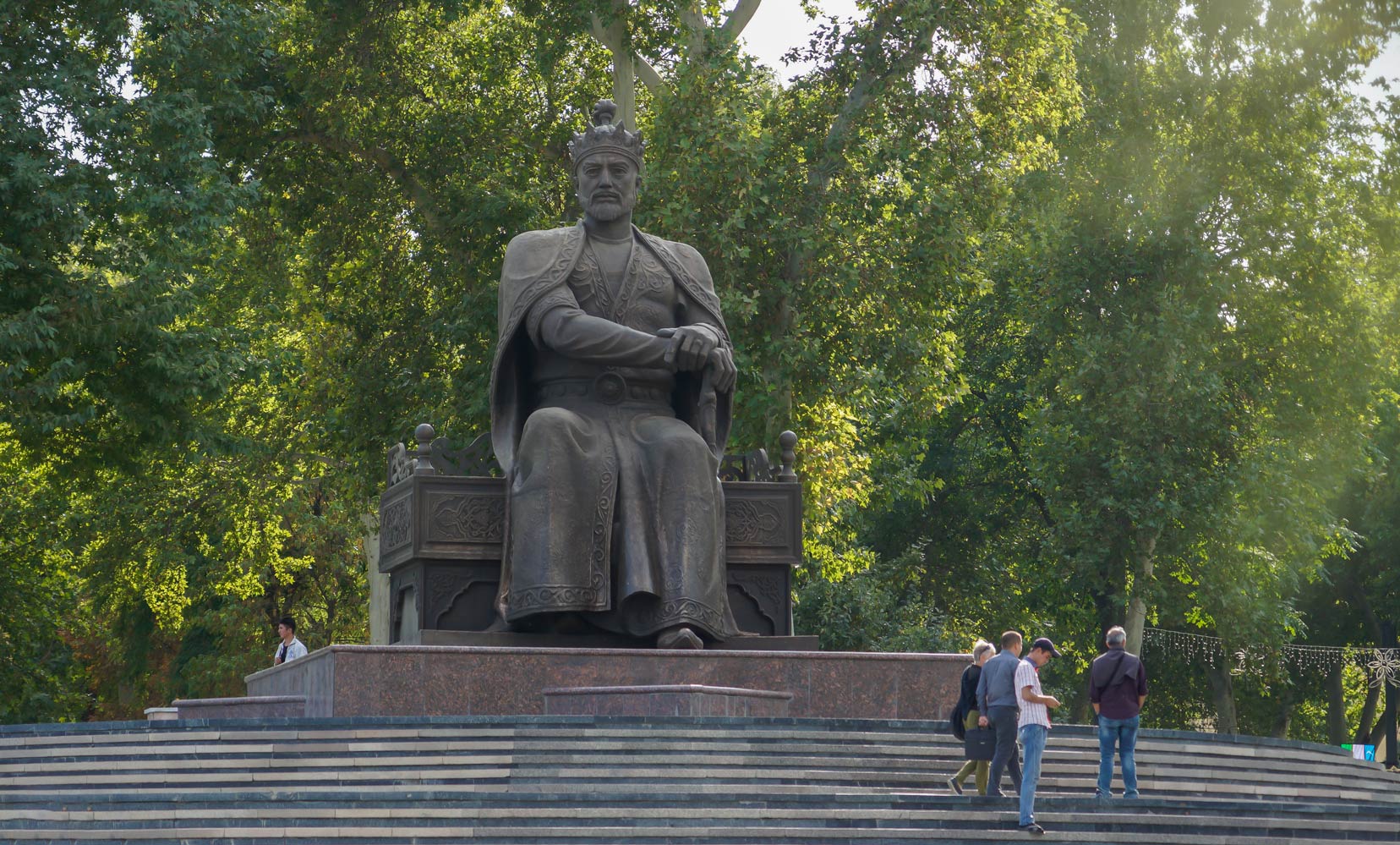
12. Hazrati Hizr Mosque
The Hazrati Hizr Mosque was built between 1854 and 1919 on the foundations of an existing structure and measures 16m x 30m. It is known to have been built to an outstanding architectural standard. Close by is a separate minaret.
Please be aware that you are not allowed to take photos inside this mosque. We did not enter ourselves but chose to enjoy the street views instead.
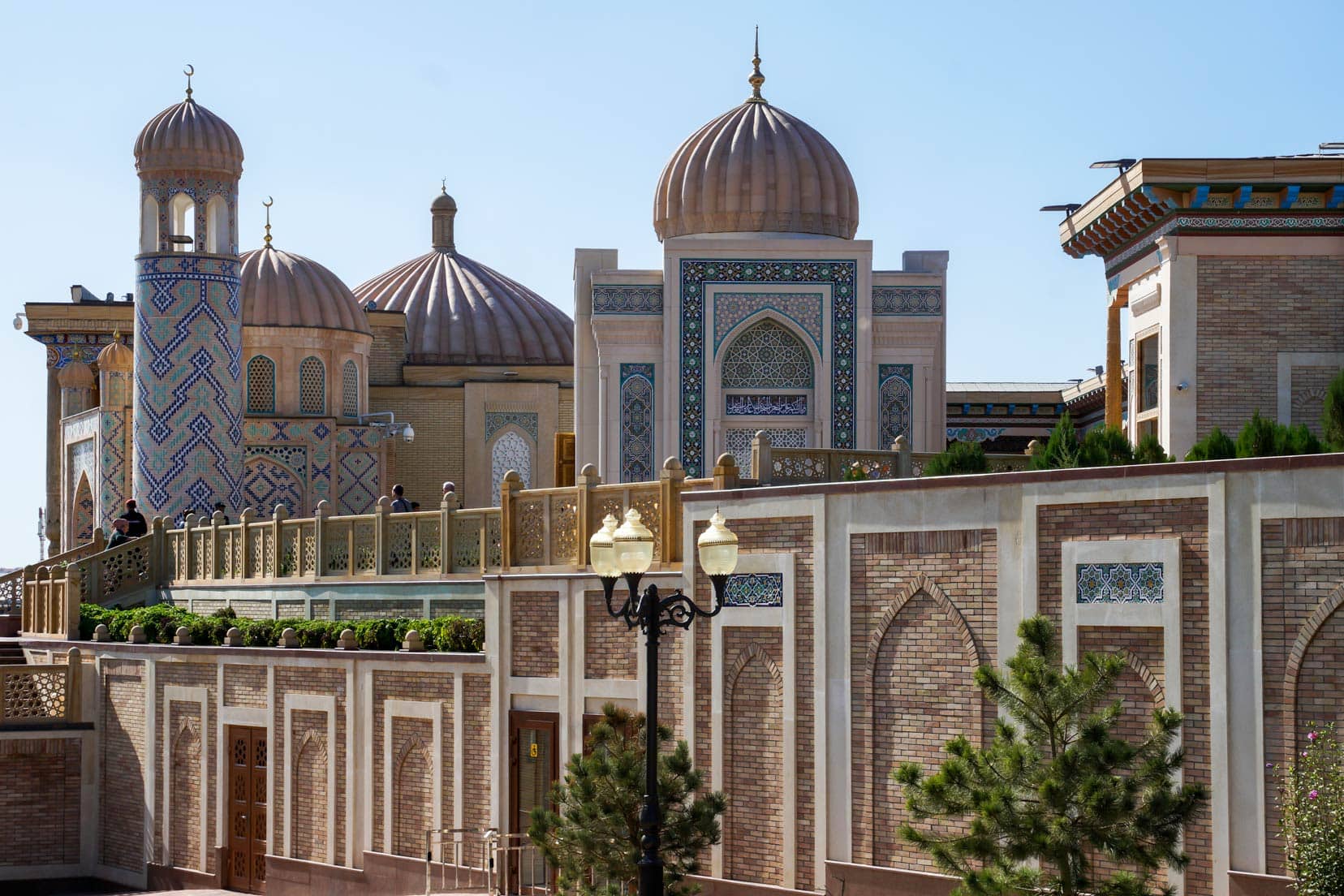
13. Islam Karimov Memorial
A mere 350m from Registan Square is the bronze statue of Islam Karimov, Uzbekistan’s first president, who reigned from 1991 to 2016 following the country’s return to independence.
The statue was formally opened on August 31, 2017, by the current president, Shavkat Mirziyoyev.
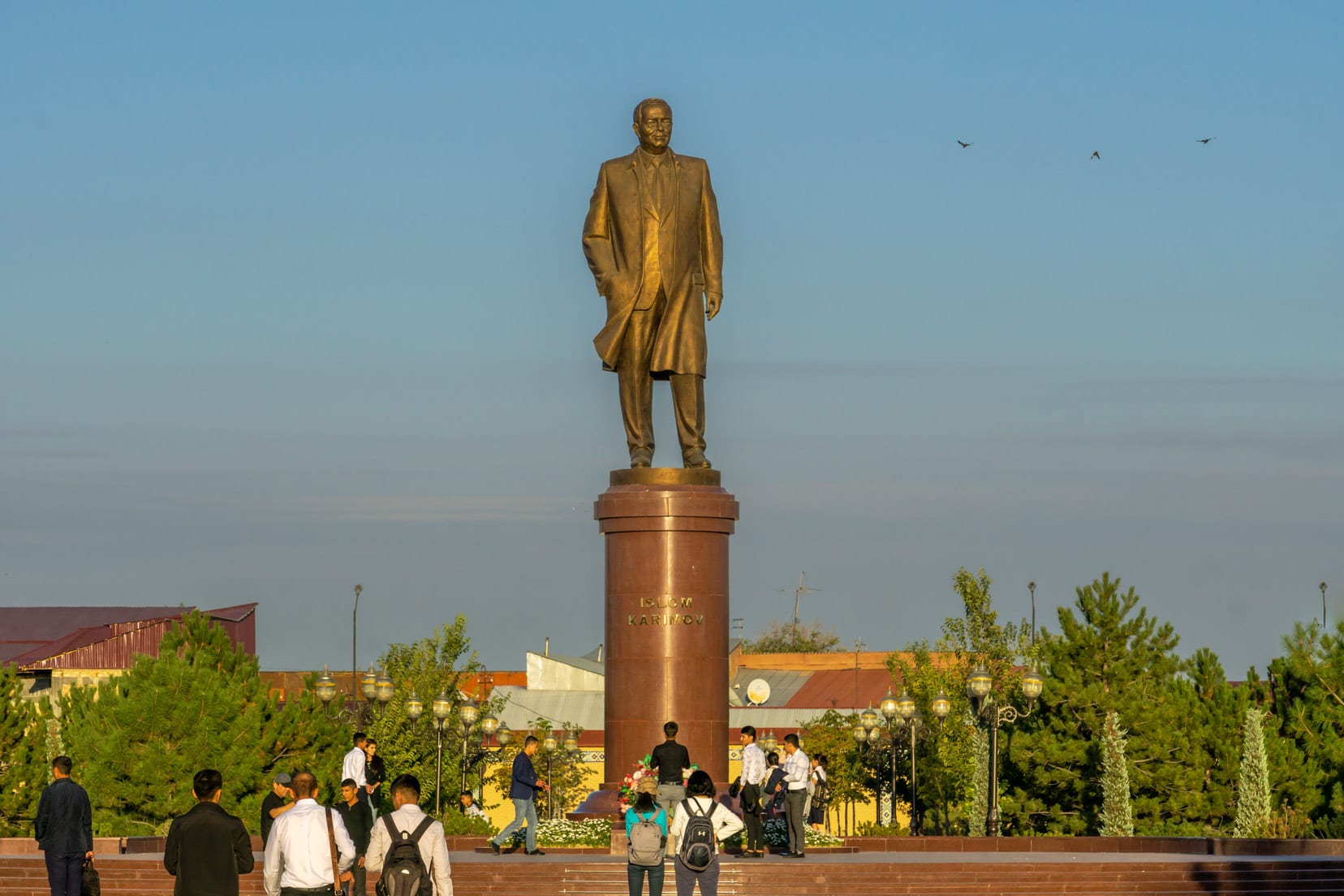
14. Visit the Ulugh Beg Observatory
The remnants of Ulugh Beg Observatory, built in the early 15th century by the grandson of emperor Timur, Ulugh Beg, were only discovered in the early 20th century.
The building originally housed a huge sextant with a 40-m radius, carved from the surrounding rock and used as a meridian arc. It is now called the Fakhrī sextant.
Astronomers used the rock to measure the angle of elevation of bright celestial objects and azimuths, generating a star catalogue of over 1,000 stars and pinpointing their locations in the night sky.
This Observatory has been given Ubekistans’s highest level of cultural protection. It is approximately 4.5 kilometres to the northeast of Registan Square in the foothills of Chupan-ata mountain.
15. Samarkand Street Art
Close to Registan Square, a long wall of street art, stylised in a similar fashion to that of the historical artisans, can be seen. This wall of sequined tiles has been tastefully constructed and blends well into Samarkand’s background.
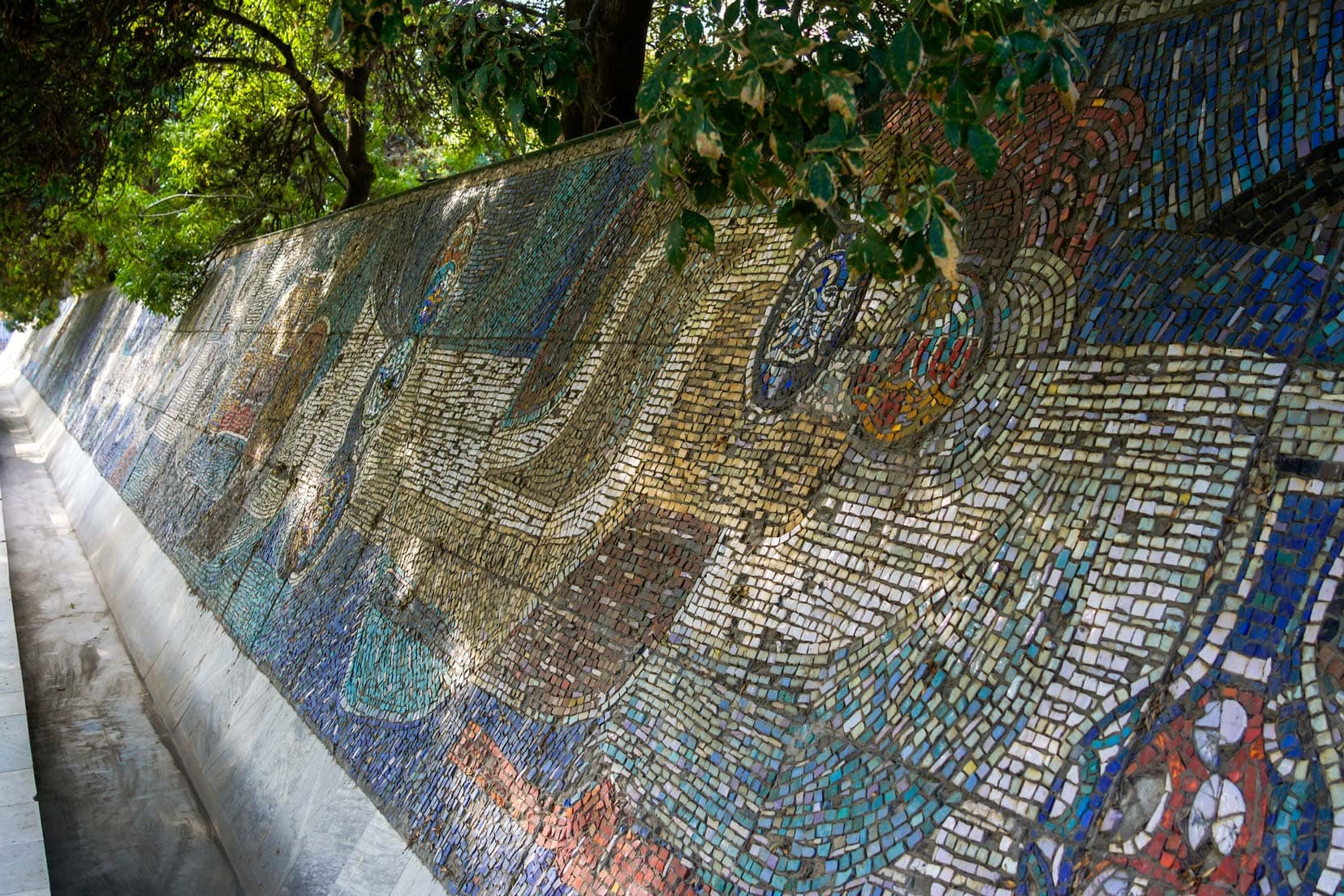
16. Samarkand Statues Depicting Life of Old
Dotted in locations around Registan Square are real-life bronze statues depicting characters from life now past. It makes for some nice photographic opportunities and makes for a natural fit into historical Samarkand.
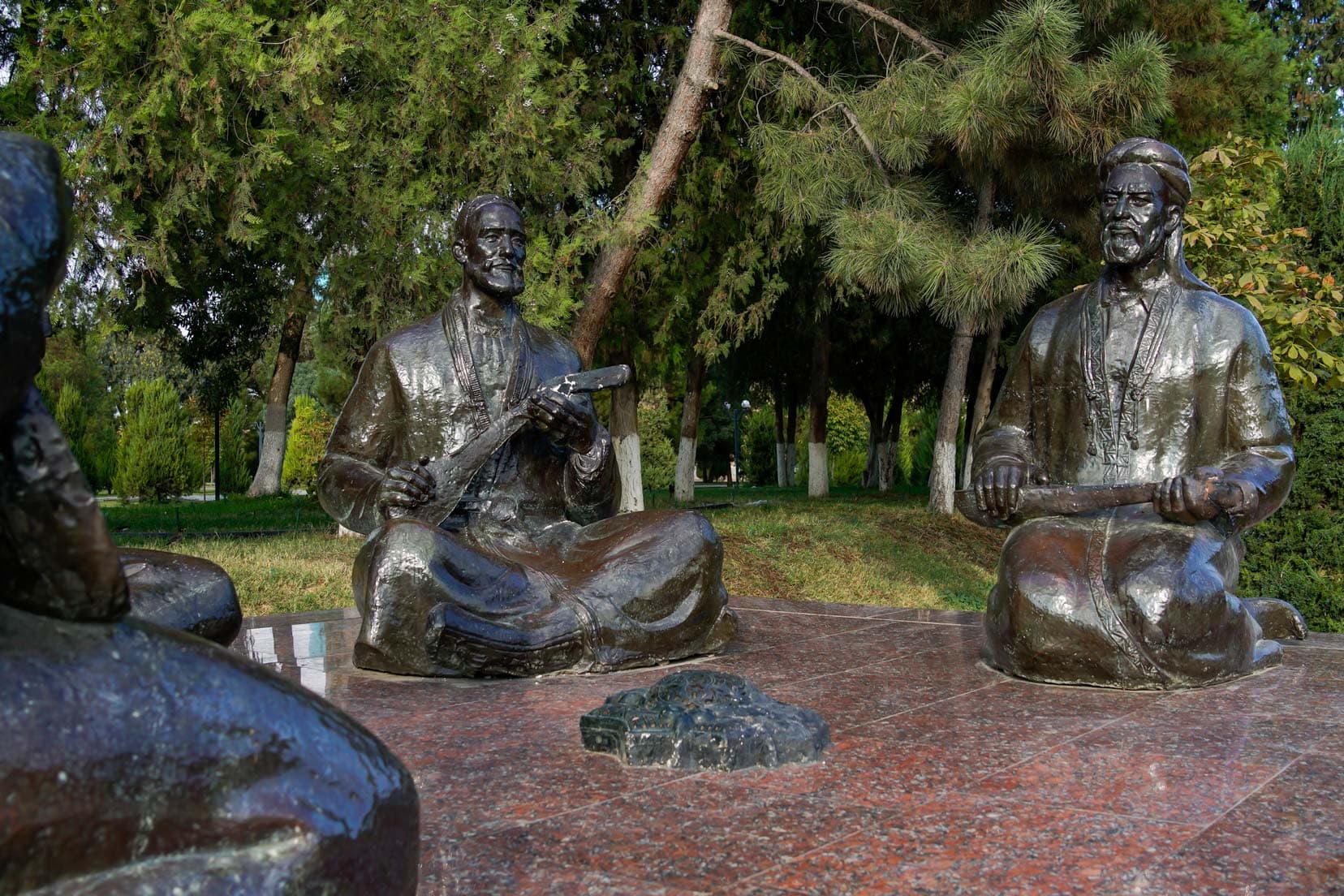
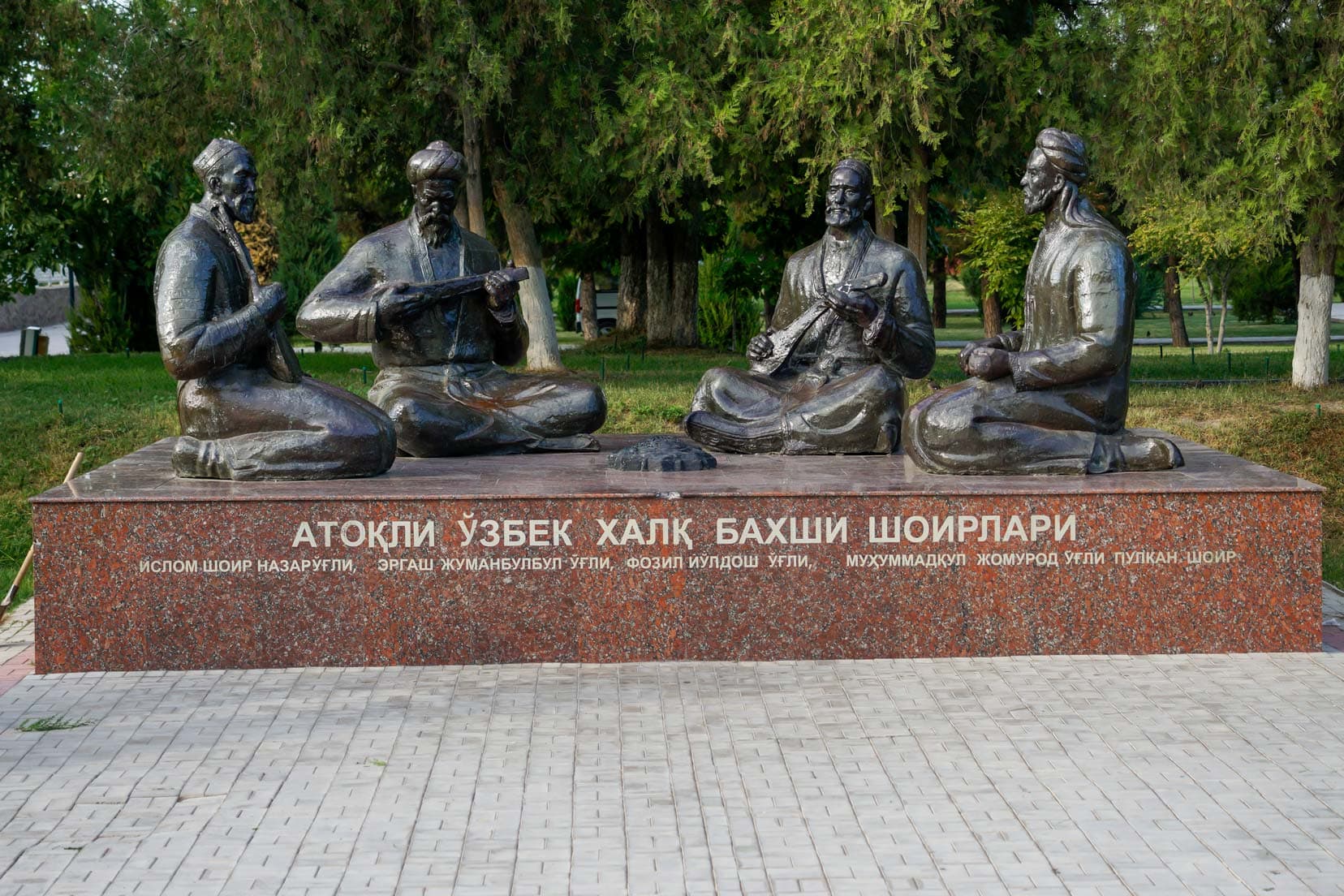
Travelling to Samarkand: Your Options
Samarkand is accessible via several easy and cost-effective options.
By Train:
If you’re already in Uzbekistan, traveling from Tashkent or Bukhara to Samarkand by train is not only affordable but also enjoyable and safe. Uzbek trains are known for their cleanliness, comfort, and punctuality, providing a delightful way to see the countryside.
The journey typically takes about 2.5 hours. Tickets can be conveniently purchased online through Uzbekistan Railways (select the English language option) or at the station if you prefer to buy them on the day of travel.
Consider booking ahead to ensure a seat, especially if you’re on a tight schedule. Upon arrival at the station, simply present your passport and ticket for inspection, have your bags x-rayed, and follow the signs to your platform.
Note: The platforms use Cyrillic numbering; if confused, don’t hesitate to ask a friendly local for help.
By Taxi:
A taxi ride to Samarkand takes roughly two hours and might be a more convenient choice depending on your schedule in Uzbekistan. Arrange a taxi service through your hotel concierge to get the best rate. Expect to pay around USD$200 for a one-way trip. Hotel staff are generally very helpful and responsive to guests needing travel arrangements.
By Plane:
Flying to Samarkand is another viable option. Flights from Tashkent take about 55 minutes with Uzbekistan Air. Check Skyscanner for possible bargains, which can sometimes be cheaper than taking a taxi, especially if your time is limited.
Where to Eat in Samarkand
Here are a couple of great restaurant options that we can personally vouch for (refer to map):
Sharq Shirinliklari: This restaurant is about 300m from Registan Square and serves traditional Uzbek cuisine. The food wasn’t the cheapest, but it was certainly tasty.
Bobur Shashlik: Tucked away behind Bibi Khanym is a local restaurant serving all types of barbequed meat kebabs. It’s the cheaper option of these two. It’s a simple process of telling the cook what meat you want and how many pieces, and it’s barbequed right where you can see it, Uzbek style.
The food was so good that we ate dinner here twice.
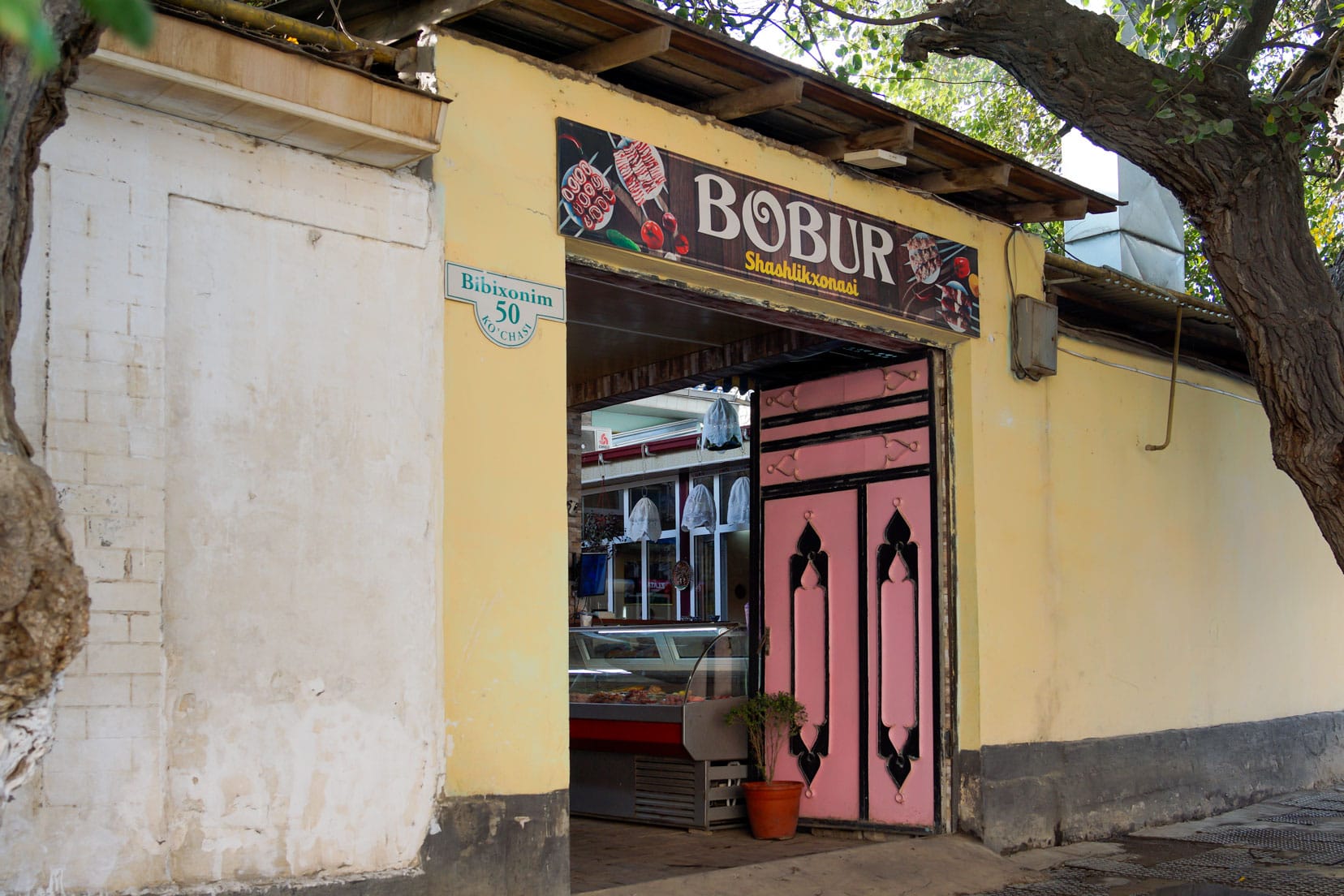
Samarkand’s Soviet History
Arriving in Samarkand, we had an interesting discussion with one of the shop owners. Although the 20th-century Russian occupation of many other countries has been associated with negative impacts, it was largely welcomed here in Uzbekistan.
The Soviets allowed the Uzbek people more equality than their old ways had allowed under Islamic rule. A good example is that the Soviets encouraged and made it possible for girls to attend school.
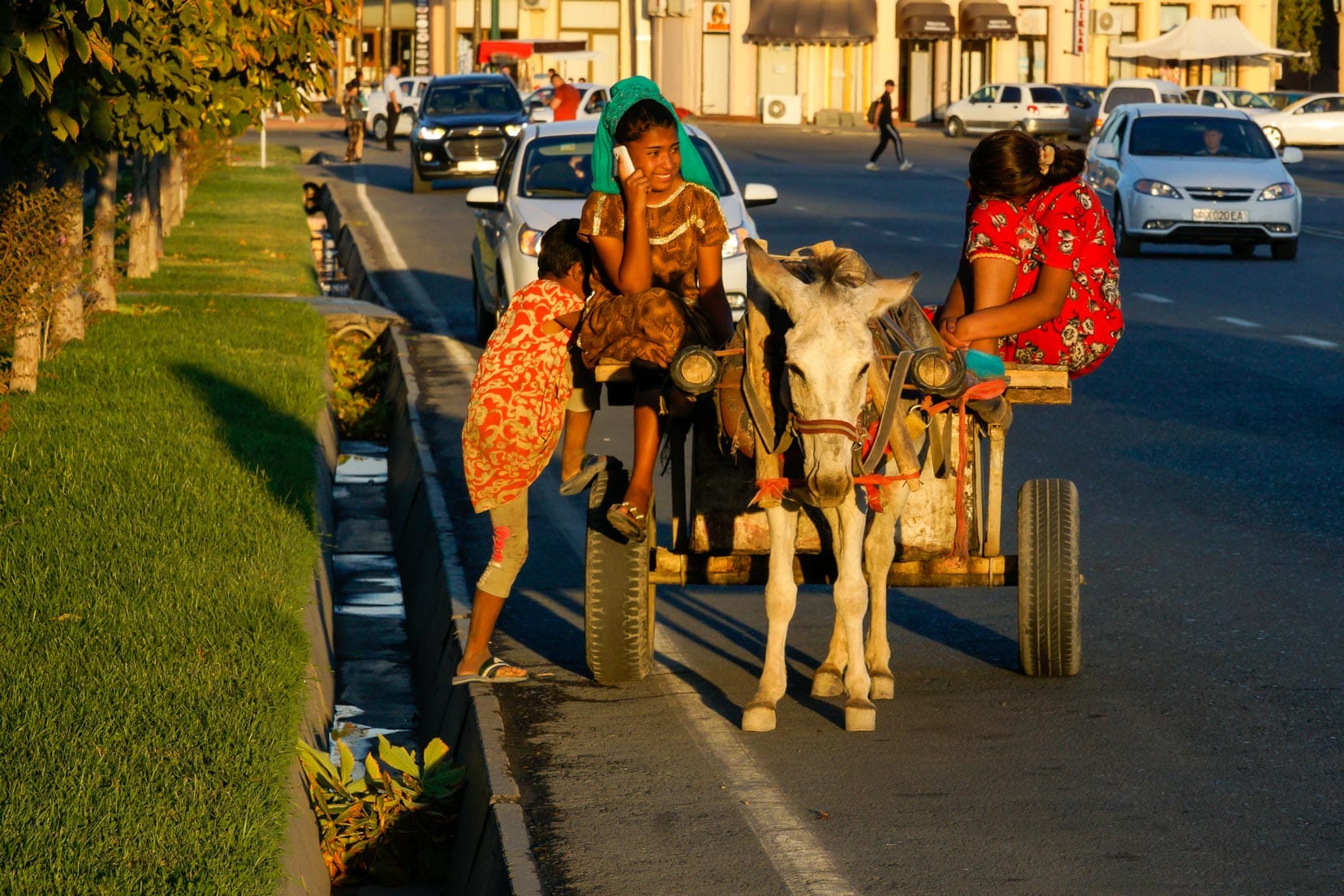
Another very important task that the Soviets undertook was the much-needed restoration of many of the ancient buildings, returning them to a state close to that of their former glory.
The disrepair over the many centuries caused by earthquakes and harsh weather had taken its toll on the beautiful facades of these grand structures. This prompted a rise in tourism, injecting much-needed capital into the economy.

Is Samarkand Worth Visiting … That’s a Wrap
Samarkand is a captivating destination offering a mix of history, culture, and local experiences. From the beauty of the iconic Registan Square to the wondrous necropolis of Shah-i-Zinda, Samarkand’s architecture, history, and local culture will leave you in awe.
You May Also be interested in reading:
- Khiva to the Aral Sea – an Incredible Day Trip
- How to Travel Cheaply
- Travel Gifts for the Travellers in Your Life
Save and Pin for Later
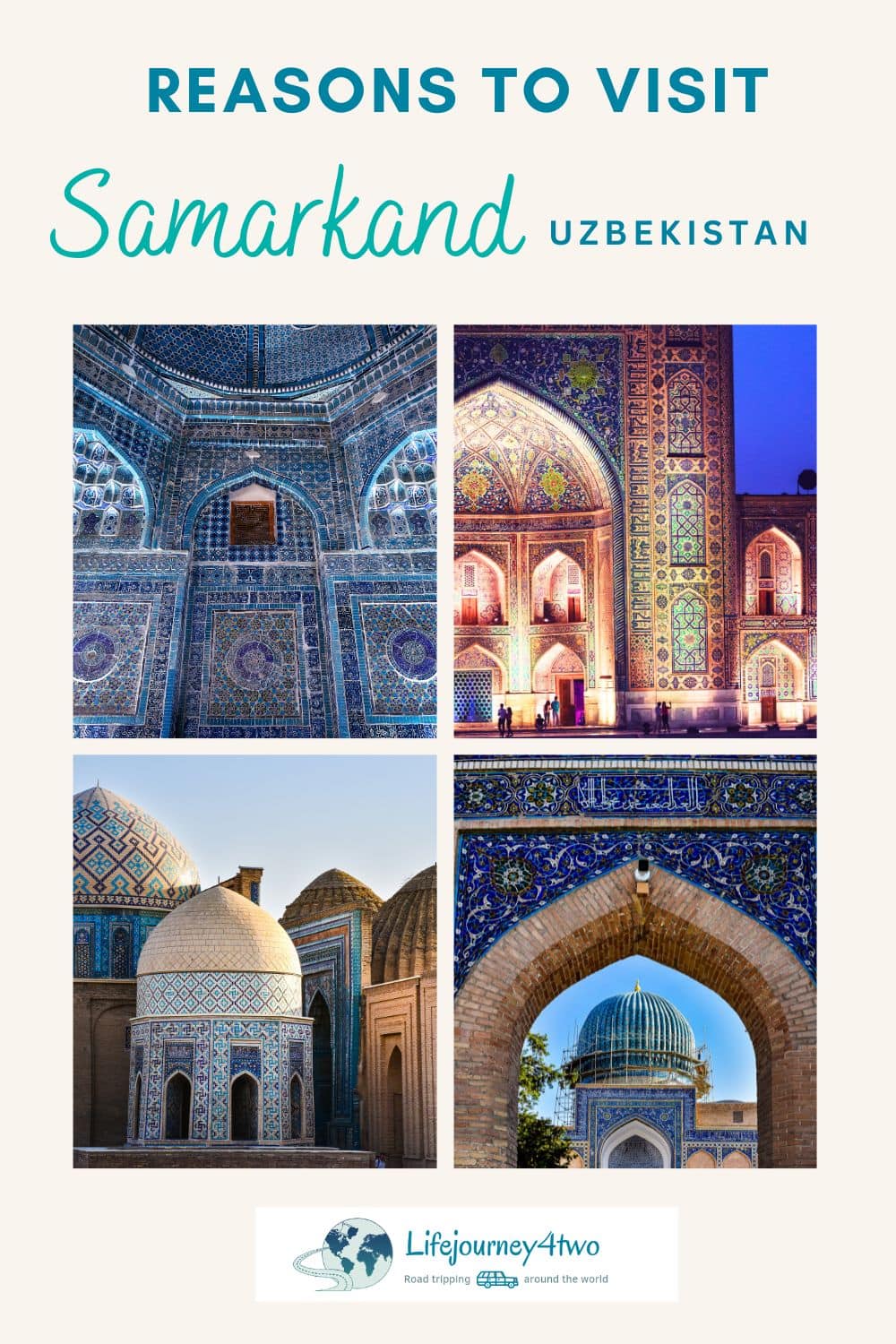
PLANNING YOUR TRAVELS?
These are some of the travel resources we use when planning our trips.
- 🚘 Car Hire: We use DiscoverCars.com
- Motorhome/Campervan Rental: We highly recommend the Motorhome Republic
- 🛏 Book Accommodation: We use Booking.com to find accommodation that suits our budget
- 🆓 Free Accommodation: Check Out TrustedHousesitters here
- Activities and Experiences: Get Your Guide and Viator
- Travel Insurance: World Nomads
- 🥾 Travel Gear and Accessories: Check out our top picks here — Lifejourney4two page on Amazon
- 🛒 Wall Art: Shop our ETSY store
For a more thorough list visit our Travel Resources page here.

